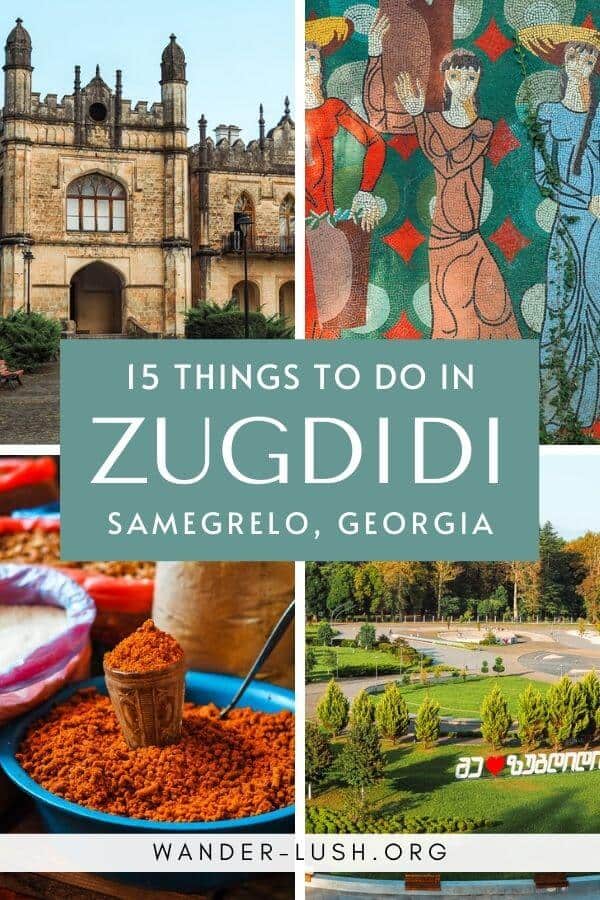17 Things to Do in Zugdidi: Ultimate Zugdidi Travel Guide 2025
33 min readA complete travel guide for Zugdidi, Georgia. Includes the best things to do in Samegrelo’s biggest city, suggested day trips from Zugdidi, where and what to eat, travel tips, plus a recommended itinerary.
There’s nothing I love more than visiting a place that only has a couple of well-known attractions and digging out more information. Cities like Zugdidi are the reason I travel – and the reason I love Georgia so much!
Zugdidi is the largest city and administrative capital of the historic Samegrelo Region. For most people, it’s just a quick whistle stop on the way to the mountains of Svaneti (Mestia and Ushguli). Take a few days out of your travel schedule to explore Zugdidi, and you will find a wealth of things to see and do – from royal palaces and Soviet-era mosaics to vibrant markets and some of the country’s best restaurants.
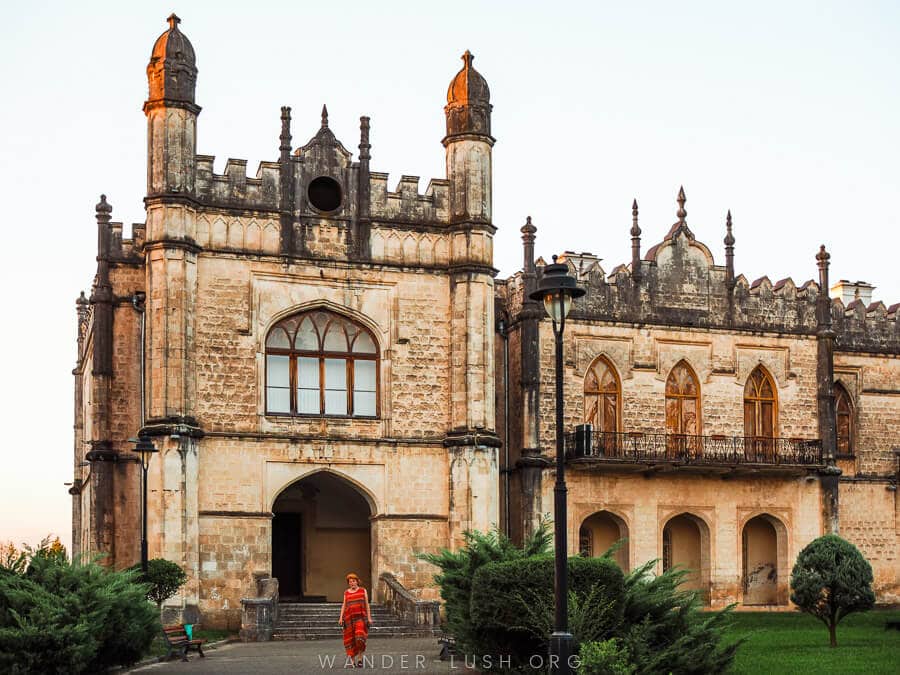
The first time I came this way in 2017, I spent a grand total of 40 minutes in Zugdidi waiting to board a bus. Later on, I saw some photos of the Dadiani Palace and promised myself I’d return one day to see it in person.
Well, the time finally came, and I decided to spend a full two weeks in Zugdidi two summers ago. Now that I live in Kutaisi, I go back to visit Zugdidi at least once a year.
While it’s true there might not be a lot of well-known attractions here (aside from the Dadiani Palace of course), like every other small city in Georgia, Zugdidi has its charms.
In this case, the best things to do in Zugdidi beyond the palace mainly revolve around Megrelian culture and cuisine. And plenty of urbexing, too.
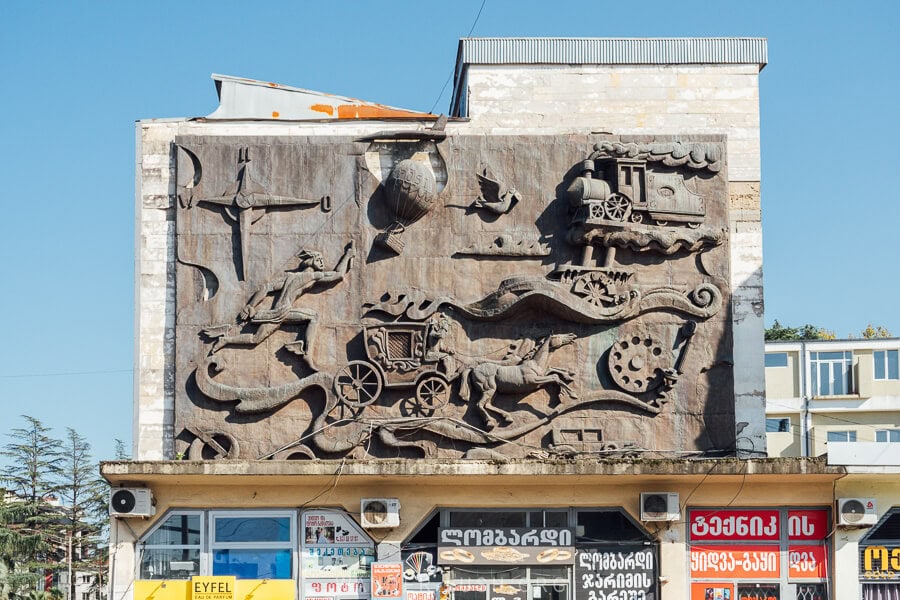
In this guide, I’ll show you 17 wonderful things to do in Zugdidi, plus my favourite Zugdidi restaurants and Megrelian dishes. I’ll also share practical information for getting to and from Zugdidi and other tips to help you make the most of your stay.
My aim is to encourage you to spend a day or two in Zugdidi and discover Samegrelo region, which is definitely one of my favourite parts of Georgia. If I succeed in persuading you, please drop me a comment at the end and let me know about your travel plans!
Please note: This post contains affiliate links, meaning I may earn a commission if you make a purchase by clicking a link (at no extra cost to you). Learn more.
Why visit Zugdidi?
Samegrelo is a fascinating part of Georgia and Zugdidi, its biggest city, is the region’s cultural and culinary capital.
Samegrelo is the ancestral land of the Mingrelians, one of Georgia’s ethnic groups who have their own language, traditions and craft heritage, including clay pottery, folk singing and dance.
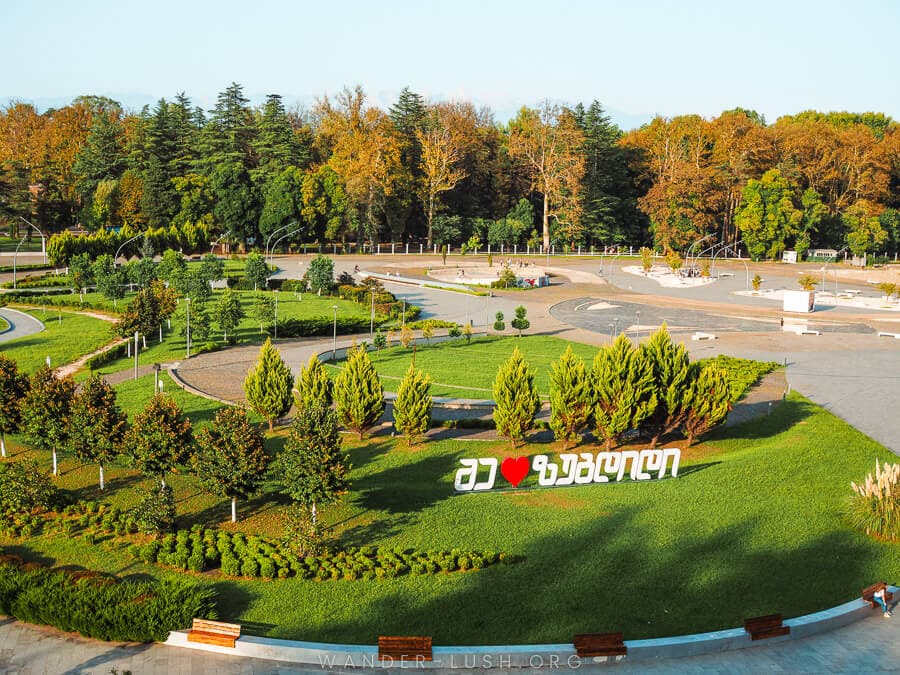
One of the most compelling reasons to visit Zugdidi is to taste Mingrelian food: spicy adjika, rich kharcho and stretchy elarji are among the highlights.
Most people know Zugdidi as the home of the Dadiani Palace. And herein lies another interesting facet of Zugdidi’s history: it’s royal connection.
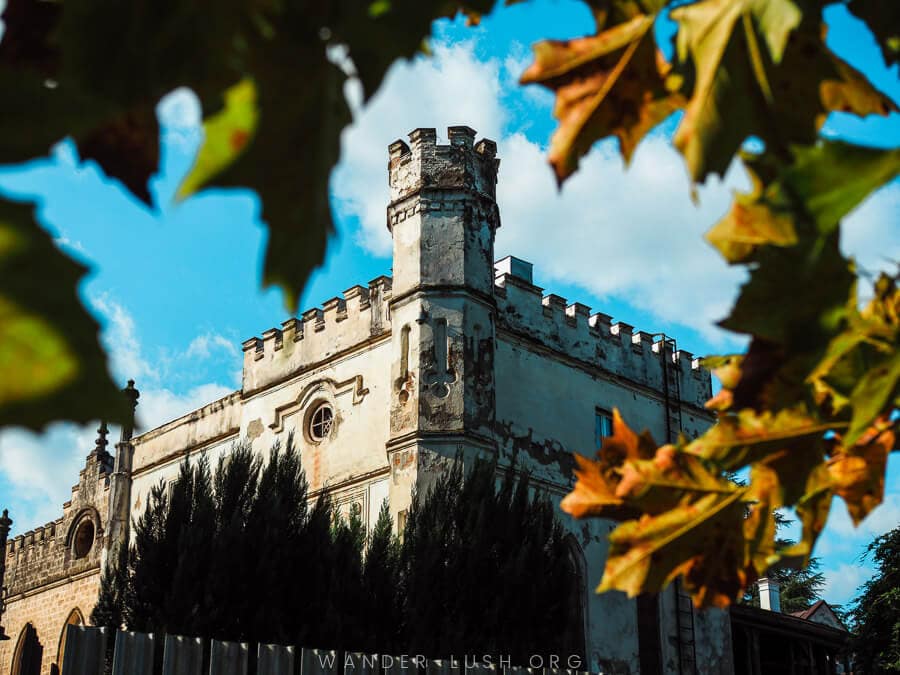
The Dadiani dynasty ruled Samegrelo (then known as Odishi) from the 11th century and had a presence here until 1867 when the last prince was forced to abdicate by Imperialist Russia. Salome Dadiani, Prince David’s daughter, married Achille Murat, the grandson of Napoleon Bonaparte’s sister – hence the family’s connection to French royalty.
Their former residences and the cultivated garden they established are Zugdidi’s main tourist attractions today.
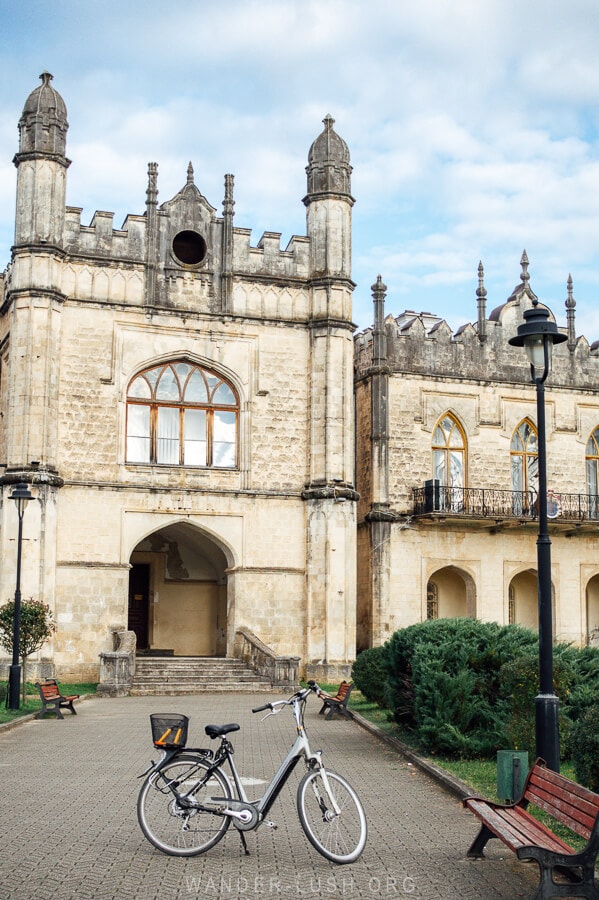
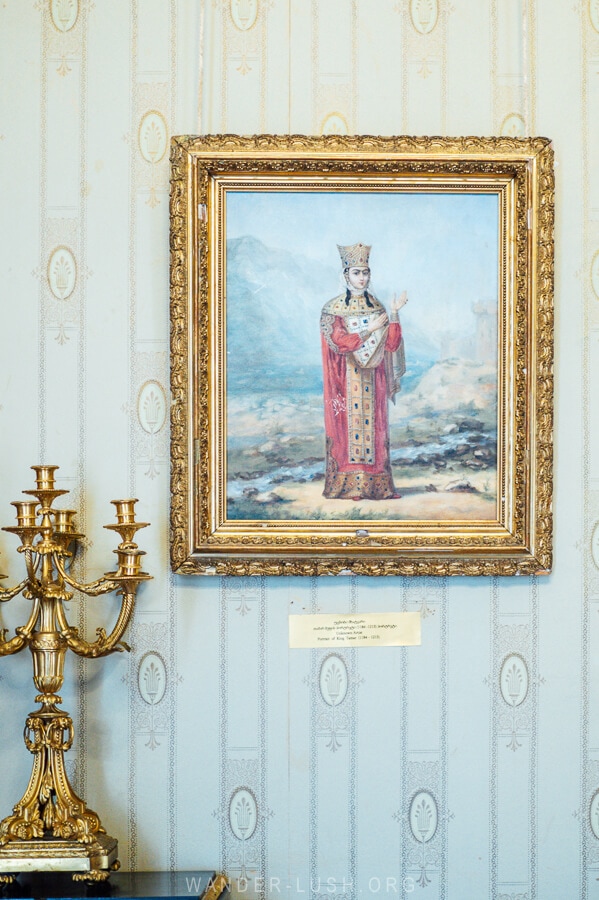
Beyond the Dadiani Palace, downtown Zugdidi has an industrial, Soviet feel.
Huge apartment blocks covered with mosaic tiles and Soviet friezes sit beside wooden oda houses with delicately carved balconies.
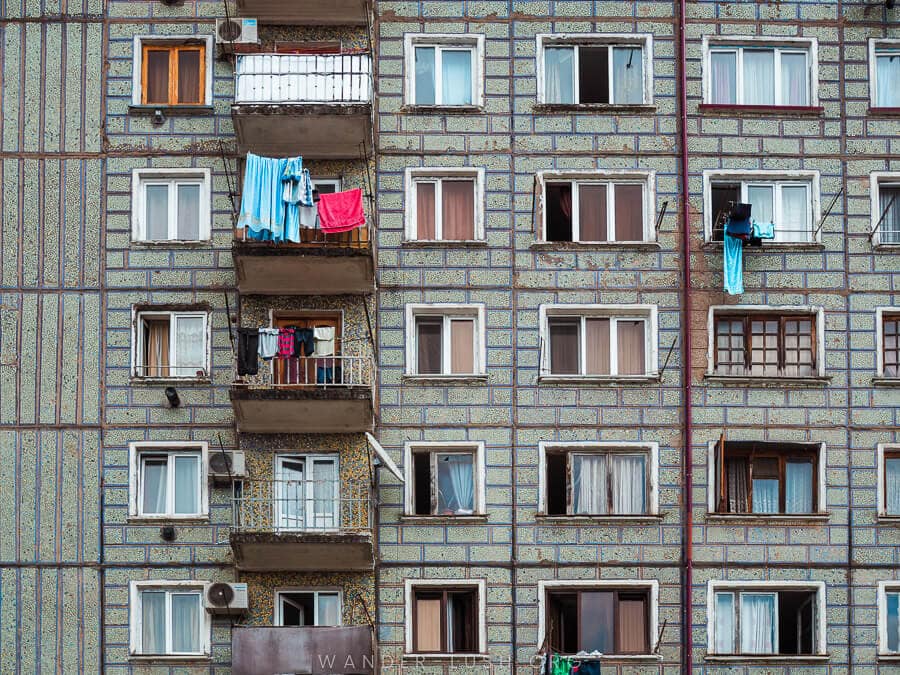
If this period of Georgian history interests you, you’ll enjoy seeing the architecture in Zugdidi and mosaic hunting on the outskirts of the city.
Where to stay in Zugdidi
Zugdidi is a compact city that is easy to navigate by foot. If you are coming in by train or bus (detailed transport info provided below), then you might want to consider staying on the western side of the river in proximity to the railway station.
Casa de Khasia: This intimate guesthouse is set in a family home in the centre of Zugdidi. It features a sprawling vegetable garden, shady terrace spaces, a library, and an external kitchen set up in the traditional Mingrelian style. Double rooms all have en suites. Breakfast is included.
Although I didn’t stay at Casa de Khasia this time around, I had a full tour of the property before sitting down to coffee with the owners, Rusudan and Gia – a wonderful local couple who also founded Zugdidi’s longest-running NGO and the only Georgian radio station that broadcasts in Abkhazia. Next time I’m in town, this is where I’ll be sleeping!
Check rates & availability for Casa de Khasia on Booking.com.
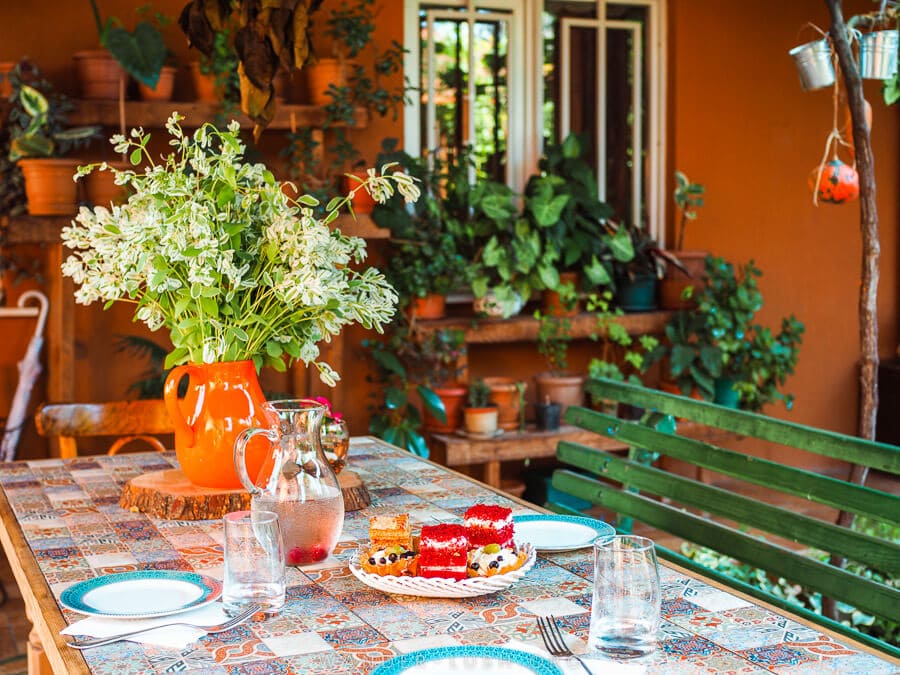
Guest House Elco: Also set in a family home, this time a few blocks from the railway station, Elco is honestly one of the best guesthouses I’ve stayed at in Georgia. Rooms are big and spotlessly clean, with great ensuite bathrooms, a kettle, and coffee and tea supplies. Owners Remidi and Elzia are exceptional hosts – when I stayed with them, they invited me for dinner and gifted me a huge bag of mandarines and lemons from the garden!
The location close to the railway station makes it ideal if you’re transiting through Zugdidi on your way to Mestia.
Zugdidi map
Click below to open my interactive map of things to do in Zugdidi.
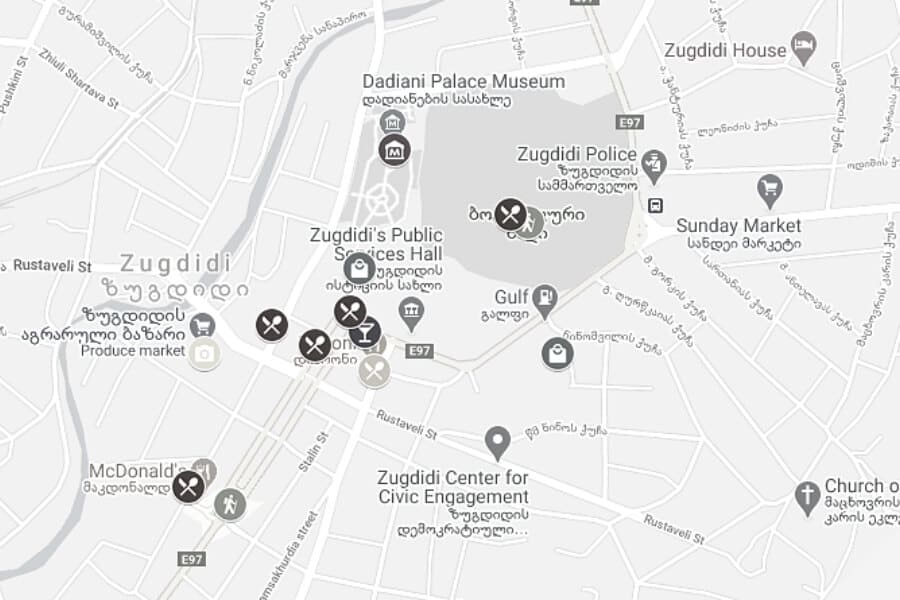
17 wonderful things to do in Zugdidi
1. Discover Zugdidi’s French connection at the Dadiani Palace
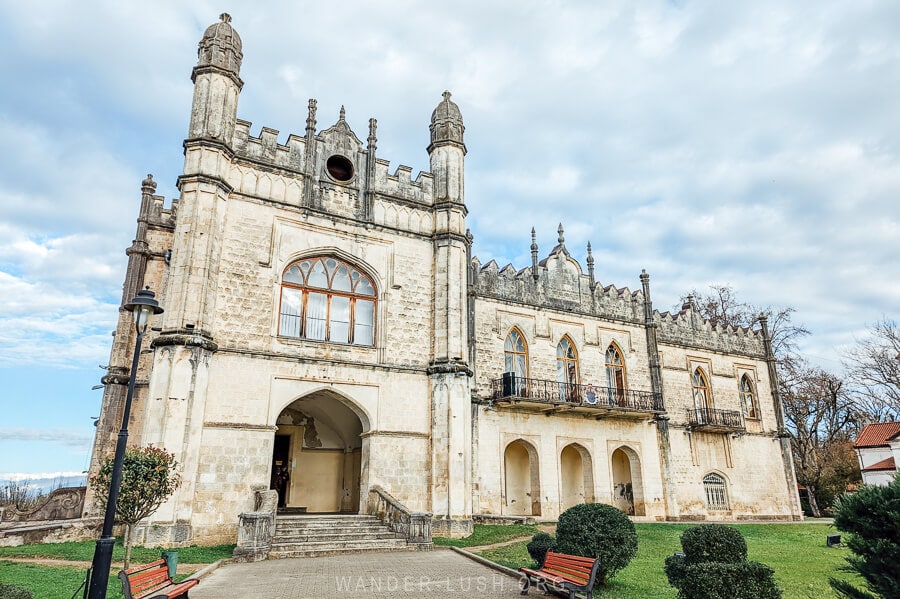
Zugdidi’s most prominent landmark and number one tourist attraction is the Dadiani Palace. This stately building sits proudly in the centre of a manicured ground adjacent to the Botanical Garden.
Taken as a whole, the Dadiani royal complex consists of two palaces, a church, and the family’s former private estate that is now the Botanical Garden (see #2 on this list below). The entrance to the manicured palace garden is marked with a grand crown-crested gate.
The main building, the Palace of Queen Ekaterine Chavchavadze-Dadiani, dates to the 19th century. Its distinctive facade features neolithic and oriental elements, while the interior had a plush Russian-Parisian vibe in its heyday.
The second palace, a separate building for Queen Ekarerine’s son, Niko Dadiani, is located adjacent to the garden (see #3 on this list below). Both royal residences are now museums.
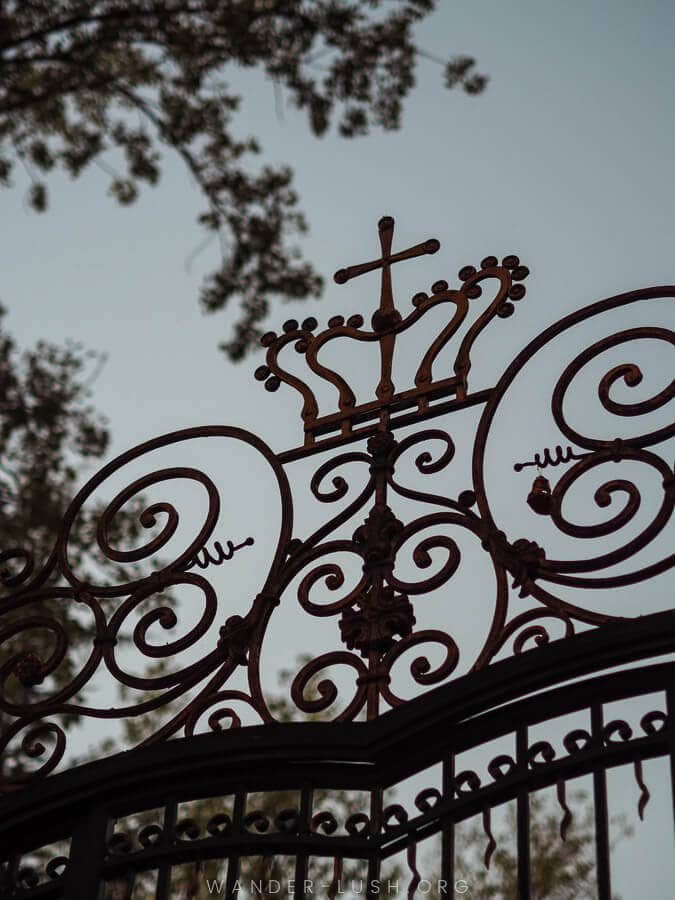
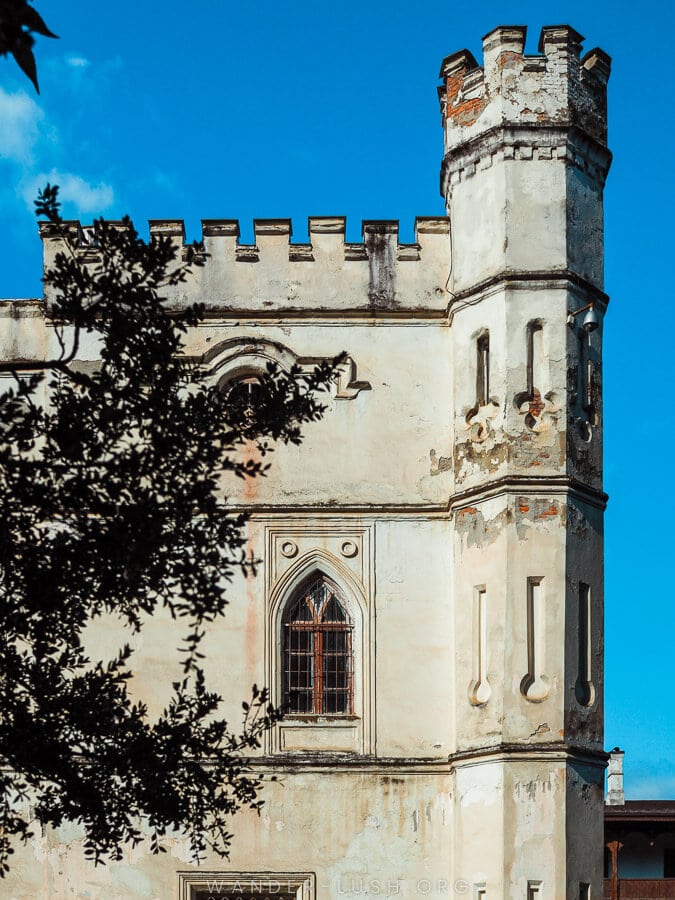
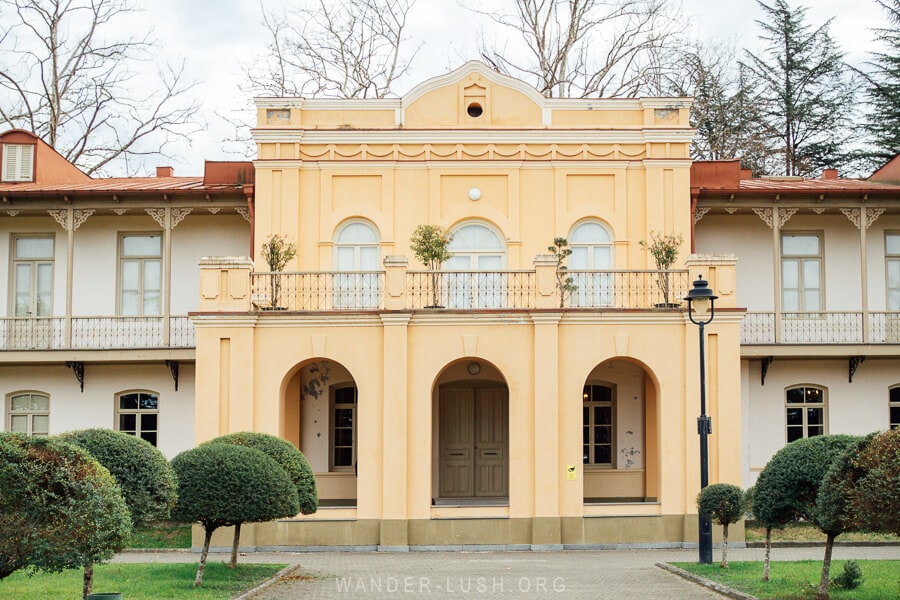
The Dadiani Palace Museum collection was established in 1839 by Prince David, making it one of the oldest museums in the Caucasus. It took its current form in the 1920s.
The collection includes some 45,000 items related to the Dadiani dynasty and Odishi, mainly precious books, coins, military paraphernalia and furniture.
My favourite items are the 19th-century paintings of Old Tbilisi and the archival images of the Dadiani family.
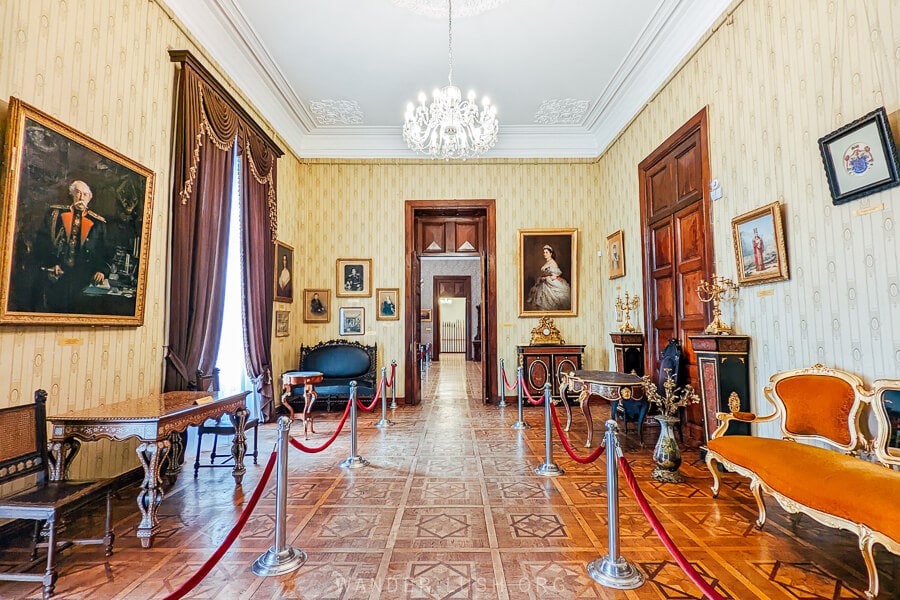
Icons and crosses from the 10th century are kept in the Treasury and can only be viewed as part of a guided tour (this incurs an additional fee).
But the highlight of the Dadiani Museum collection is most certainly the 1833 bronze death mask of Napoleon Bonaparte (one of only four in existence), acquired when Princess Salome married into the French imperial family.
When I first visited Zugdidi, it was sitting rather forlornly in a glass cabinet at the back of one of the rooms. Now the mask has a much grander presentation.
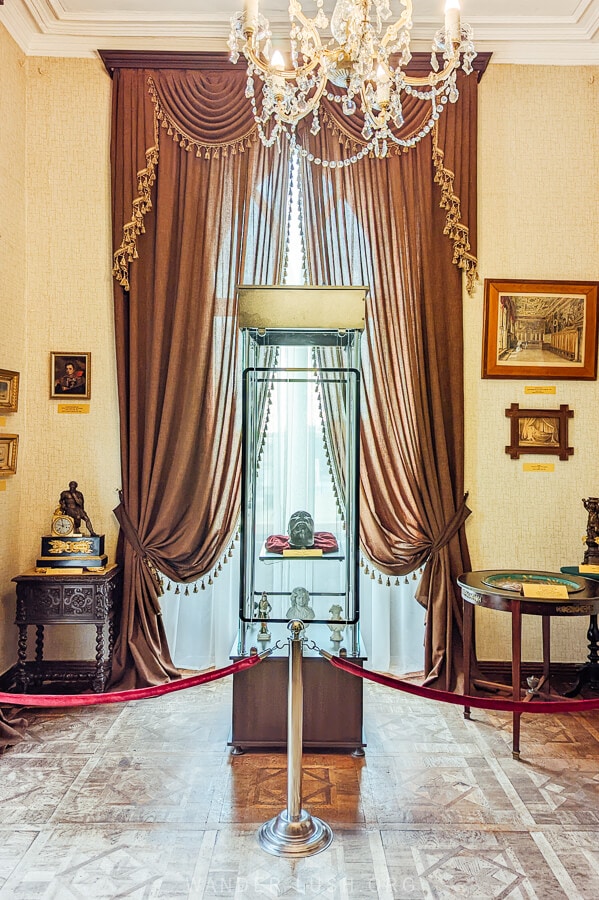
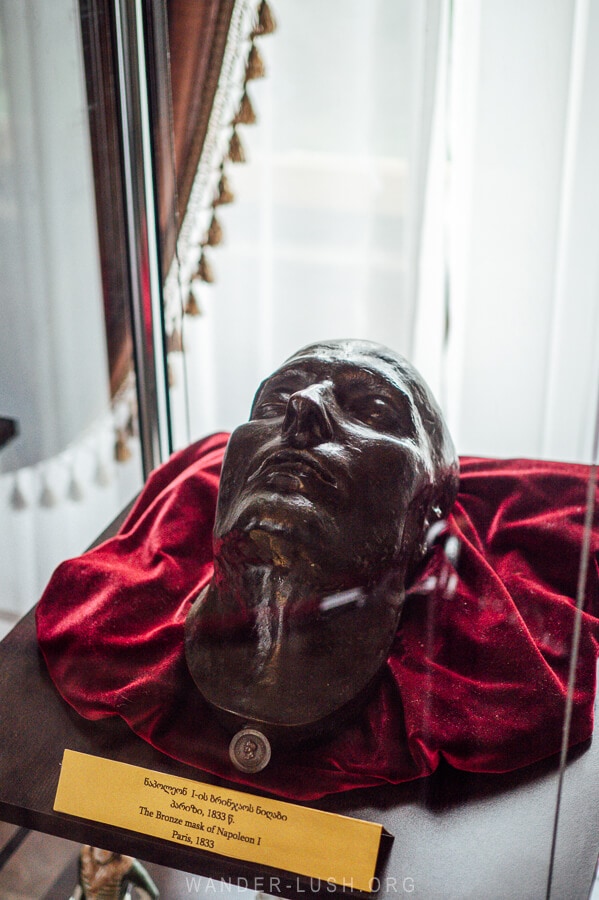
The Dadiani Museum doesn’t have much in the way of English language signage, so if there is a guide available, I recommend paying a bit extra to have someone accompany you. Otherwise, it takes around 20-30 minutes to cover the exhibits.
Photography is permitted inside the museum. Lockers are available for storing small bags – and if you’re waiting for a bus or train, you can probably leave larger luggage items behind the security desk.
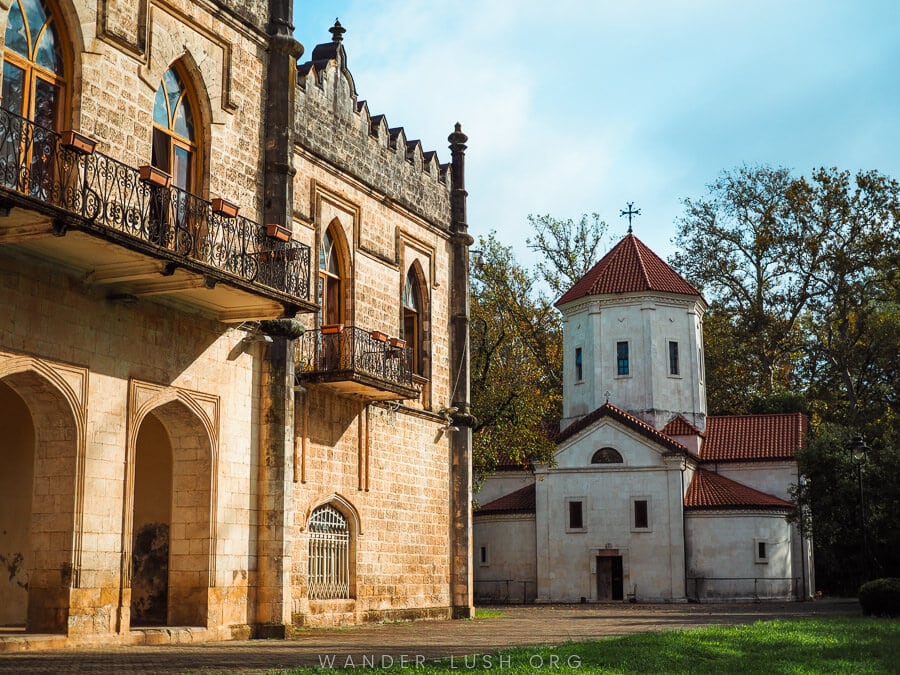
Back outside, to the right of the palace you will see the St. Virgin Mary of Vlacherna Church.
While you’re here, be sure to wander around the corner to see the rear section of the palace, the old wall, the arbour walkway, and the pair of watchtowers that look straight out of Transylvania.
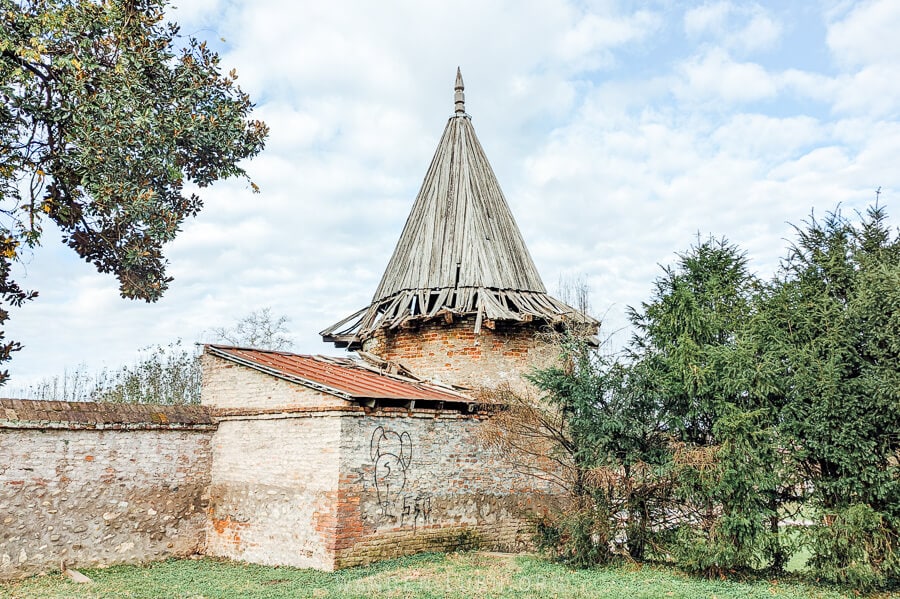
If you’re interested in following the trail of the Dadianis, you might like to track down their other residences in Samegrelo. There is a summer house in the village of Gordi (now sadly ruined), and a restored palace (Levan Dadiani’s Palace) in Salkhino.
Martvili Canyon was famously used by the royal family as a ‘private bath’ and is also very interesting to visit.
- Opening hours: 10am-5.30pm Tuesday to Sunday (closed Mondays)
- Ticket price: 12 GEL
2. Take a stroll through the Zugdidi Botanical Garden
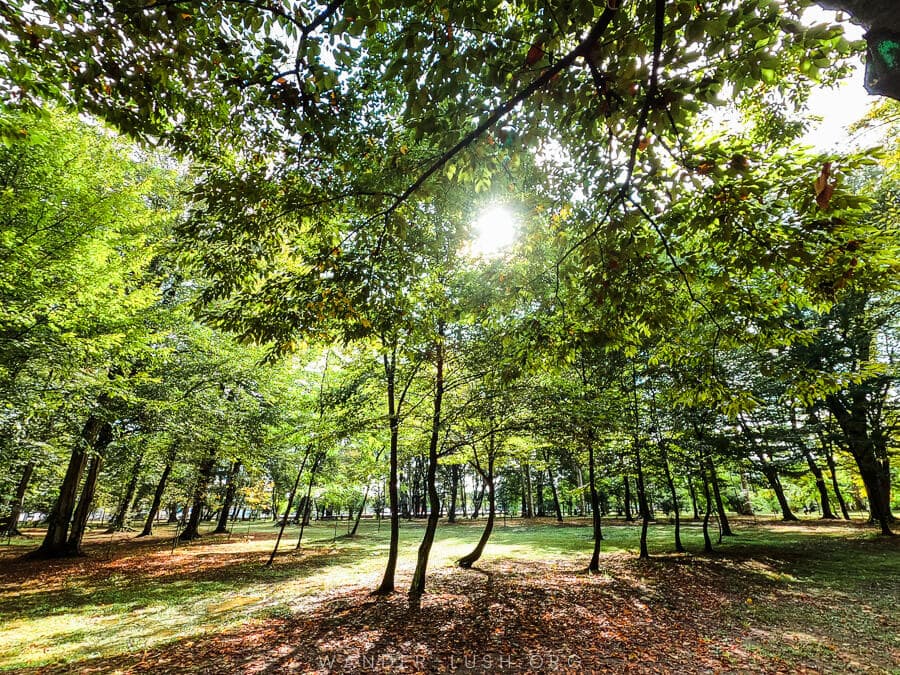
Located adjacent to the palace, Zugdidi’s Botanical Garden – formerly known as the Principal Garden – was designed by Triese-born landscape architect Joseph Babini in 1840. Planted with seedlings from France and Italy, it followed a symmetrical design and incorporated a parterre, a conservatory, and an artificial lake and island.
Deer and wild goats once frolicked in the palace gardens, which over time came to incorporate flora from around the world – and more than 700 endemic species of plants from the South Caucasus.
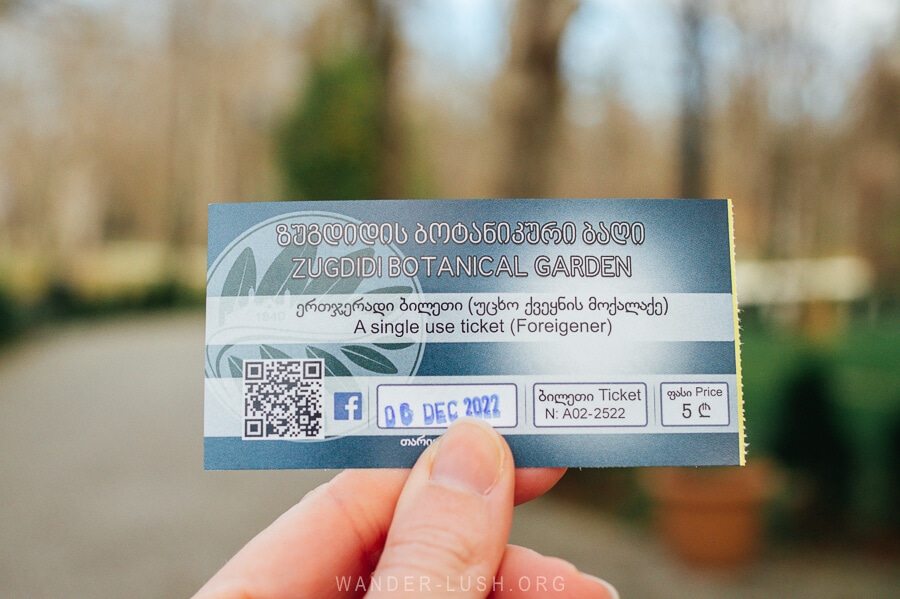
After the House of Dadiani met its demise, the family’s private grounds were converted into a sprawling public garden.
Like the Batumi Botanical Garden, it’s more of an arboretum that showcases different species of exotic trees rather than flowers or shrubs.
Much of the garden is a forest of tall, slim trunks. There’s a cafe called Botanico, a workout gym, a peacock cage, and even a camping area (priced at 15 GEL per night).
A tree-lined alleyway cuts through the middle of the garden, linked by a series of smaller paths. There are a number of other structures to see as well, including a gardener’s house, a greenhouse, and the very pretty ruins of an orangery.
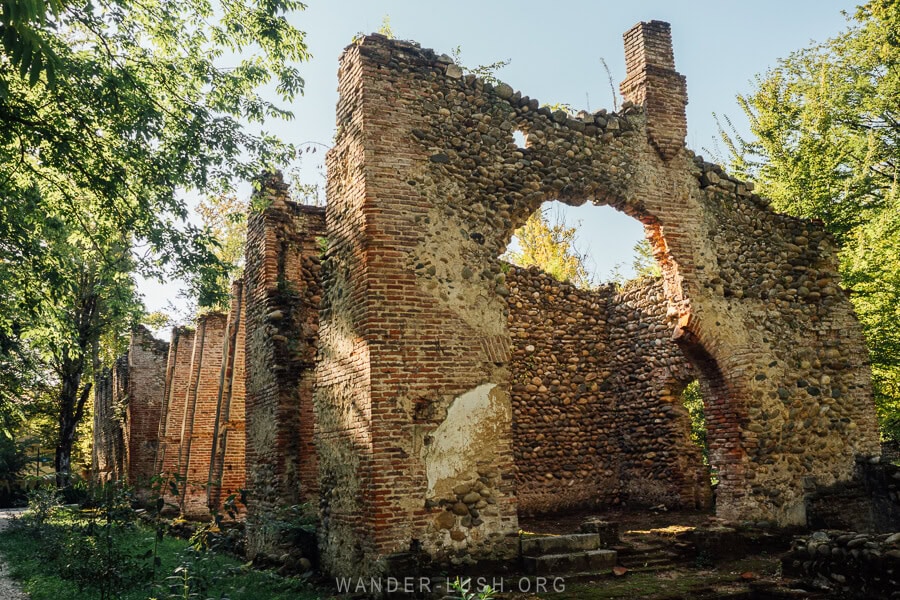
Also look out for these quirky new sculptural pieces, a collaboration between local ceramicist Robert Absandze of ORKOL Studio (more info below) and wood craftsman Zuri Shanava.
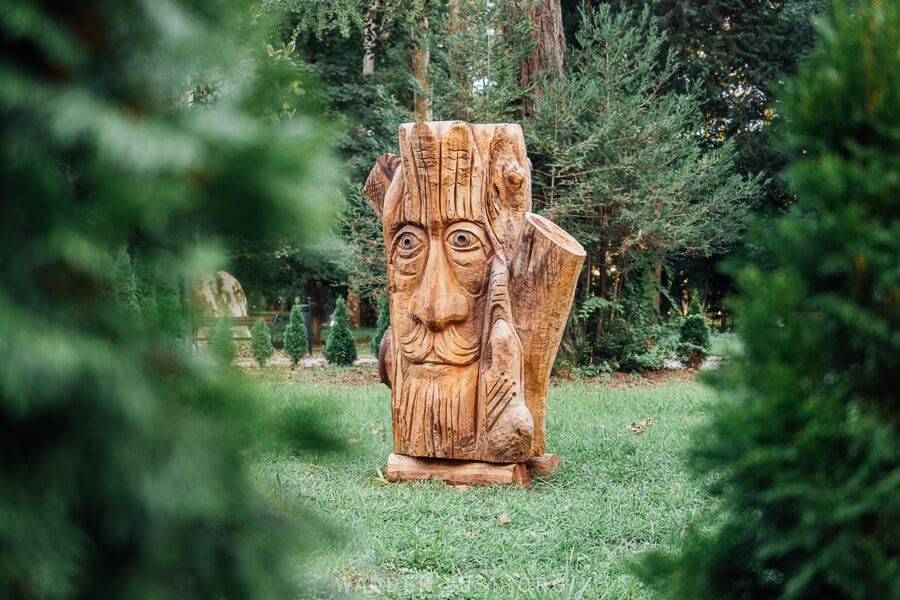
The Botanical Garden is particularly nice at dusk when the lights go on – just make sure you bring your bug spray!
Note that there are only two gates so once you’re inside, you have to commit to walking the entire length of the park or doubling back. The main entrance to the garden is located behind the southern corner of the Niko Dadiani Palace.
- Opening hours: 6am-11pm daily
- Ticket price: 5 GEL (free from 6am-9am & 9pm-11pm every day, & on the last Friday of the month)
3. Visit the second (new) museum inside Niko Dadiani’s Palace
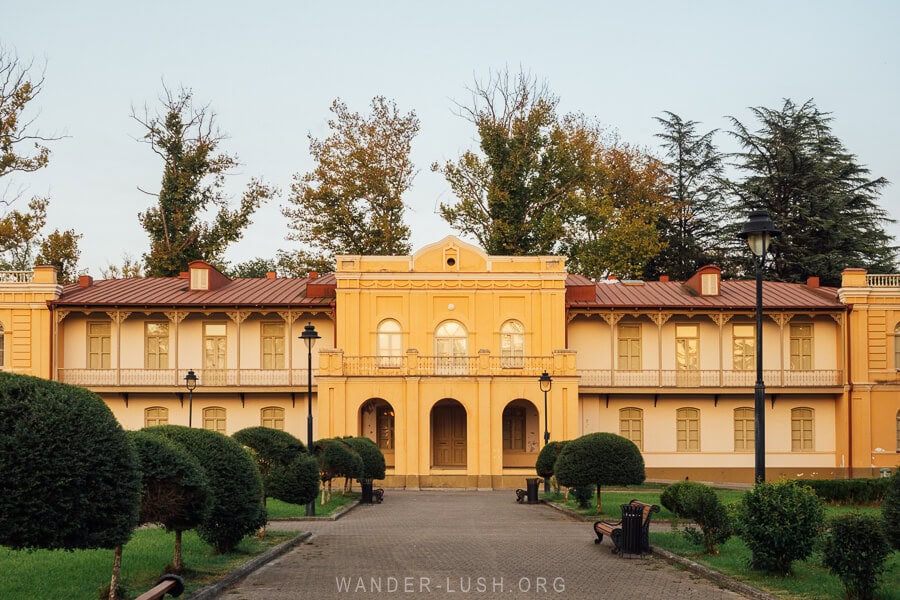
Zugdidi’s second palace, the Niko Dadiani Palace, is more pared-back but no less beautiful than its counterpart. Built in the 1880s according to the designs of Russian architect Leonid Vasiliev, it combines Russo and Georgian elements.
Inside, the largest ballroom in the country was once used to host soirees, attracting literary icons, members of the artistic community and intelligentsia from around Georgia.
Major renovations were completed in the last few years, and the palace recently reopened to the public. It currently hosts its own exhibition – but I’m told that the main collection will eventually be relocated here so that the Queen’s palace can receive some TLC, too.
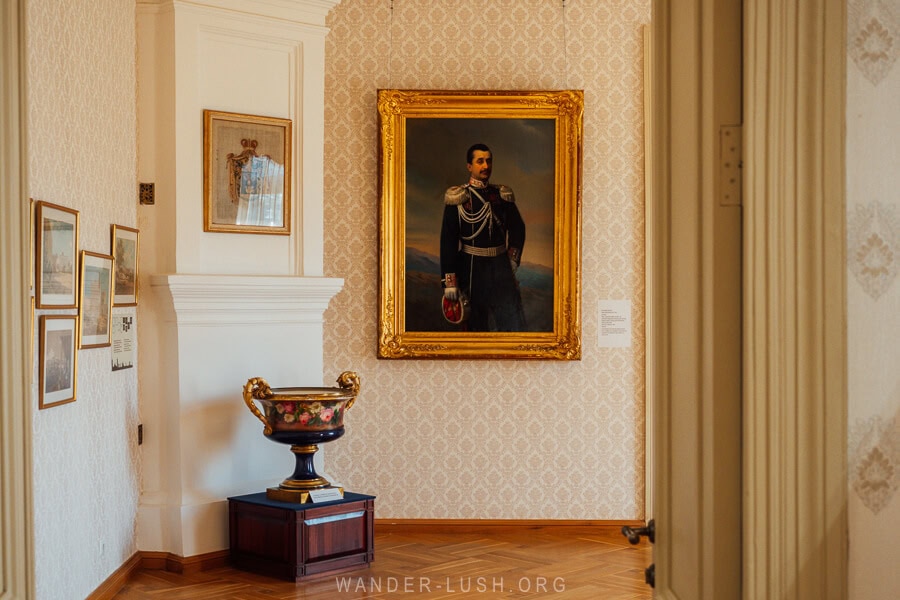
The permanent exhibition here is known as the King’s Gallery. Canvases, ceramics and etchings are displayed across several restored period rooms alongside furniture and miscellaneous objects that belonged to the last prince of Mingrelia.
The series of works by Pharamond Pierre Blanchard depicting Mtskheta, Dariali Valley and Tbilisi – as seen by the travelling French artist on his journeys in the 1850s – was definitely the highlight for me. Also on display here, the Dadiani family library contains various correspondences from Napoleon.
- Opening hours: 11am-6pm Tuesday to Sunday (closed Mondays)
- Ticket price: 5 GEL
4. Feast on traditional Megrelian cuisine at Diaroni
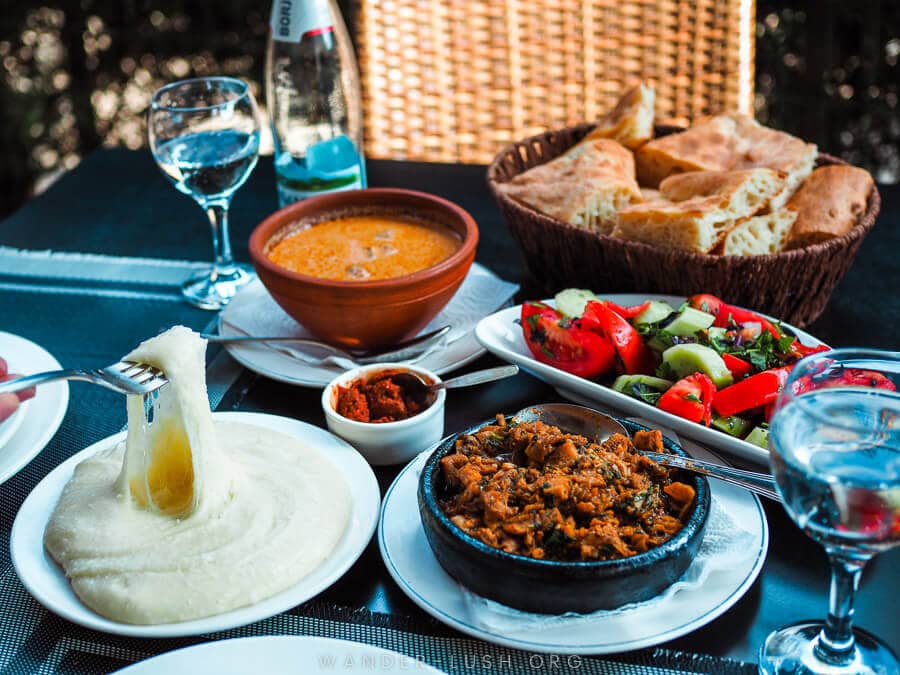
As you might know by now, every region of Georgia has its own specialty cuisine. Megrelian is probably my favourite.
Known for being deeply aromatic and spicy, many Megrelian dishes make liberal use of chilli and adjika, a regional spice ‘paste’. It’s also very dairy heavy (I don’t think I’ve ever eaten so much cheese in my life), and features cornmeal instead of wheat flour.
There are lots of restaurants worth trying in Zugdidi (my full list of recommendations is coming later), but Diaroni is widely considered the favourite for local eats. Diaroni specialises in traditional recipes and true-to-taste renditions of old classics.
The menu is extremely long, so I have put together a list of things to order:
Traditional Megrelian dishes to try in Zugdidi
- Gebzhalia: Parcels of cheese-stuffed cheese in a yogurt-y sauce flavoured with mint, chilli and lots of salt. Served cold as a side or a starter.
- Kharcho: Creamy walnut and tender beef curry-like stew spiced with adjika. The rich gravy goes perfectly with elarji.
- Elarji: Soft cornmeal ‘porridge’ blended with cheese. It’s often so stretchy, you can pull a spoon of it all the way up to the rafters! (Pictured below.)
- Ghomi: Similar to elarji, but with little slabs of cheese pressed into the top instead of blended through.
- Chvishtari: Cheesy cornmeal formed into a bar and stuffed with a bit of extra cheese before being fried in oil. Crispy and utterly moorish. Note that Diaroni’s version is big enough for two people to share.
- Puchkholia: Another cold dish made from crumbled cheese mixed with mint, salt and spices. Delicious when spread on chvishtari or served atop ghomi.
- Kuchmachi: The Megrelian version of this Georgian favourite is extra spicy. Kuchmachi is traditionally made from heart and liver fried with onions, pepper and other aromats.
- Adjika: Widely used in Samegrelo and Abkhazia, adjika is a fragrant and fiery paste used in cooking and as a side. Diaroni’s version is coarse and crunchy from the heavy use of salt. I love to eat it with bread. A little bit goes a long way.
- Megrelian khachapuri: The local version of Georgia’s famous ‘cheese bread’ resembles an Imeretian-style pie, but with extra pieces of cheese laid on top and grilled. Regional cheese is used. Think of it as a double-decker khachapuri.
- Dadiani khachapuri (Royal khachapuri): Also local to Samegrelo, this version is similar to Megrelian khachapuri but differs in the way the cheese is arranged on top (it doesn’t cover the crust).
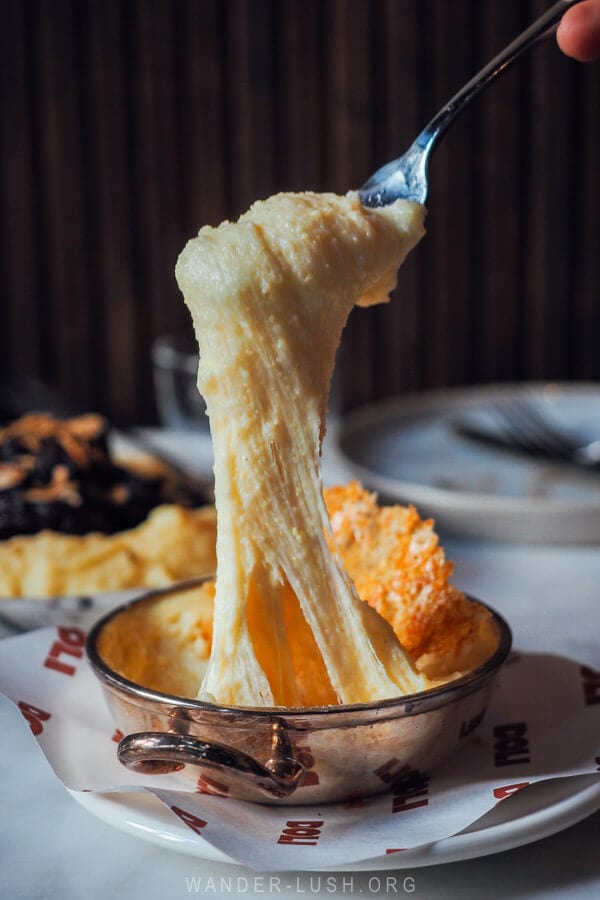
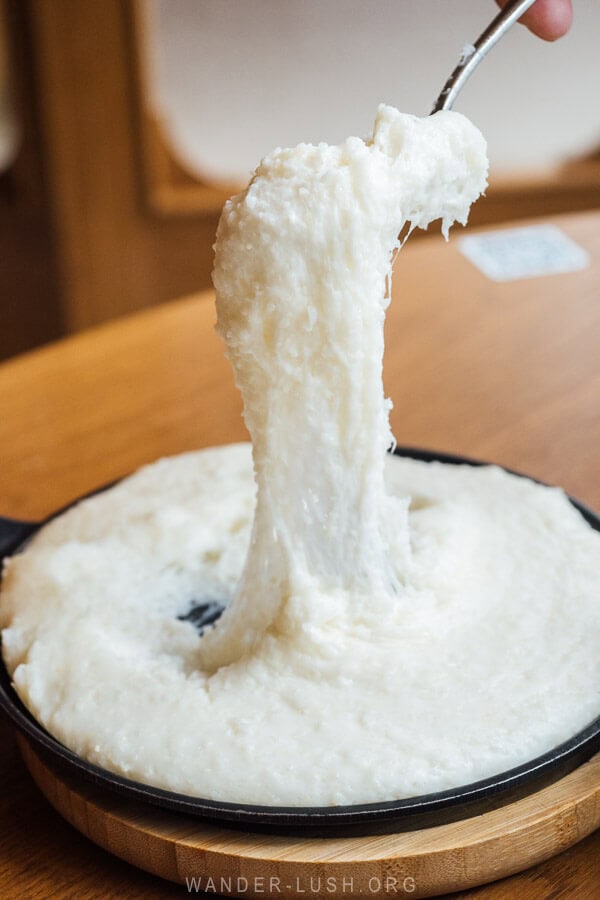
If you only have enough room for one dish at Diaroni, make it kharcho with a side of elarji. Be sure to specify kharcho with walnut – there is also a soup version from the Northern Caucasus, but that isn’t the one you want.
I was a bit concerned when I ordered kharcho on my recent trip: It came out looking a bit pale and watery. But the flavour was even better than I had remembered!
If you want to try Megrelian food in Tbilisi, there are a few specialty eateries on my list of Tbilisi restaurants. I recommend Mapshalia and Oro for all things Megrelian, Amra for all things adjika, and Shemomechama for excellent chvishtari.
5. Immerse yourself in Megrelian culture at Folk House
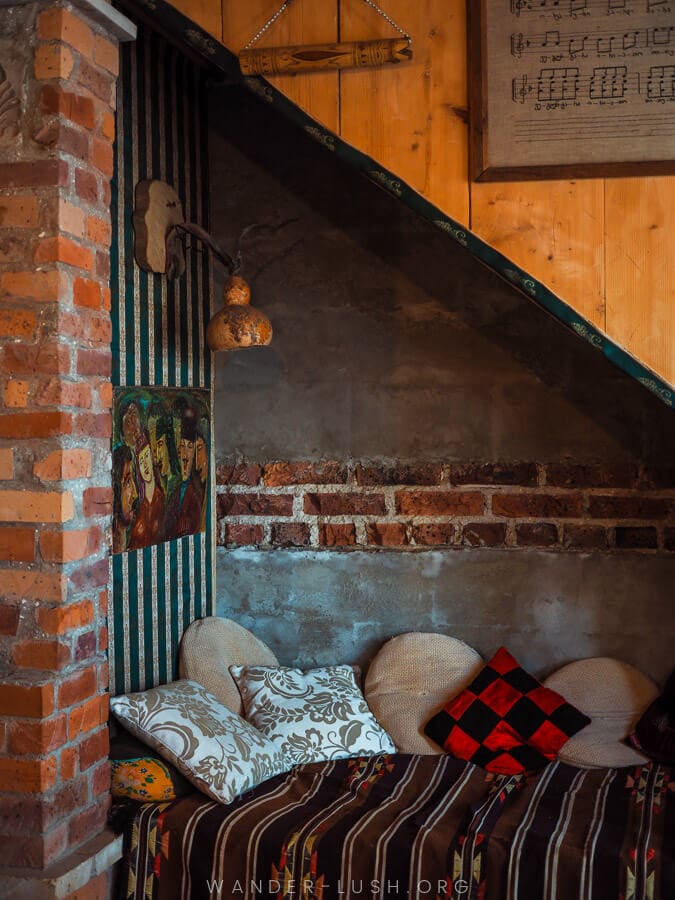
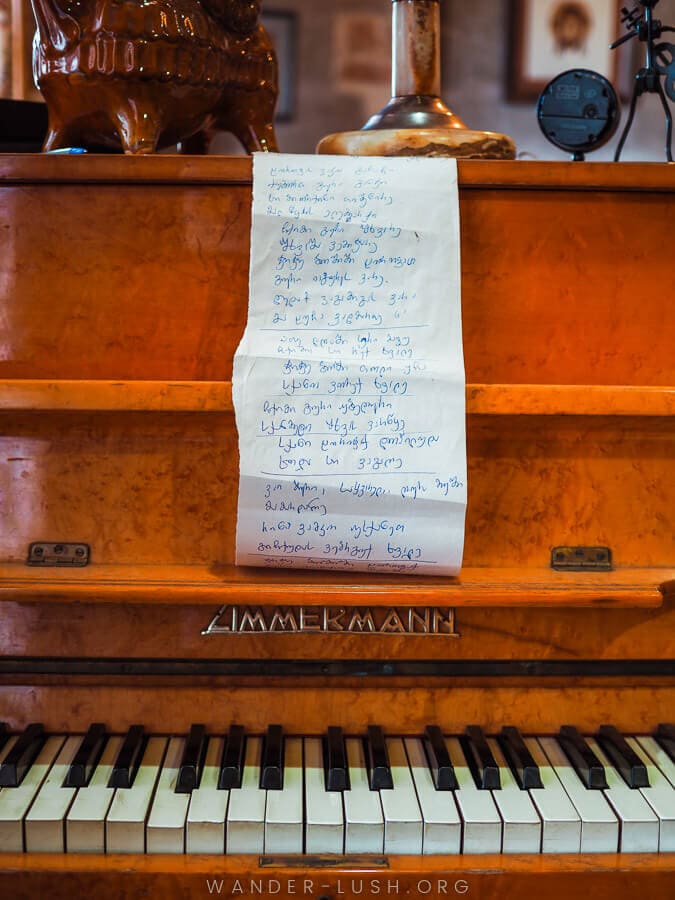
If you’re looking for something truly special to do in Zugdidi, make a booking at Folk House – a museum-studio-restaurant just past the railway station.
Folk House is a one-man project dreamed up by Besiki Tshitanava, a talented Megrelian who has dedicated much of his life to preserving and sharing his ethnic traditions. He himself is a master embroidery, a composer, a renowned polyphonic singer, an architect, a designer and a chef – among other things. His home is a showcase of artefacts, tools and instruments native to the region.
Visitors can join Besiki for a cooking demonstration and a meal. On my visit, we made chvishtari and gebzhalia from scratch using an old grinding stone to whip up the mint (‘the first blender’, as he described it to me).
In his youth, Besiki worked as a chef for the Megrelian-French royal family, hence why he speaks fluent Francais.
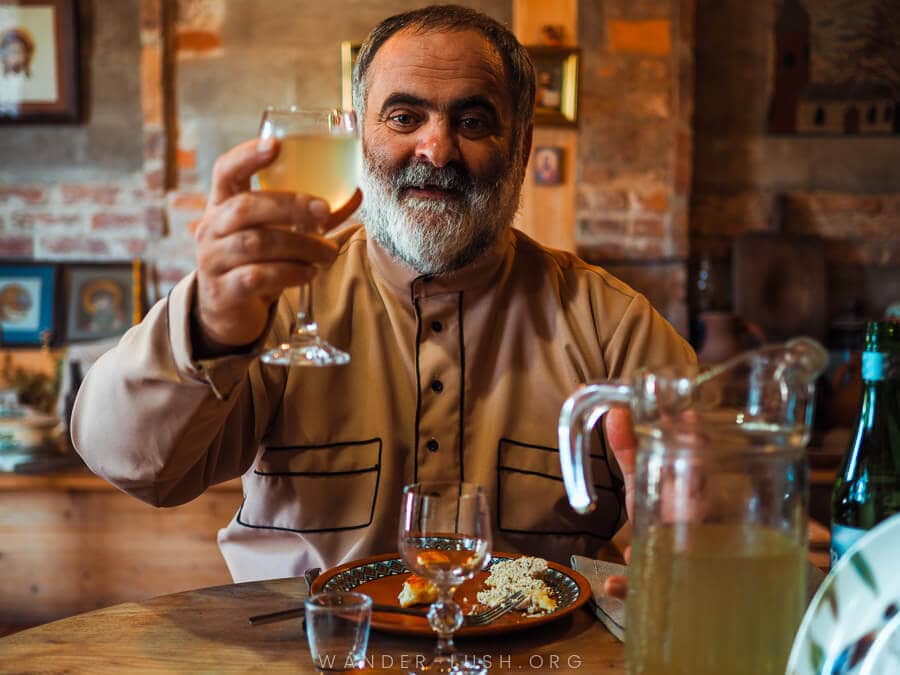
When it’s time to eat, Besiki will don his traditional shirt and jump behind the piano to belt out one of his emotional Megrelian ballads. He’s an endless source of information about the area’s heritage and culture; just being in his presence is an unforgettable experience.
Advance bookings for Folk House are essential; ask your guesthouse to call ahead. There is no sign or street number on the house, but you can’t miss it.
- Opening hours: Lunch or dinner daily (by appointment only)
6. Meet the master ceramicists at ORKOL Studio
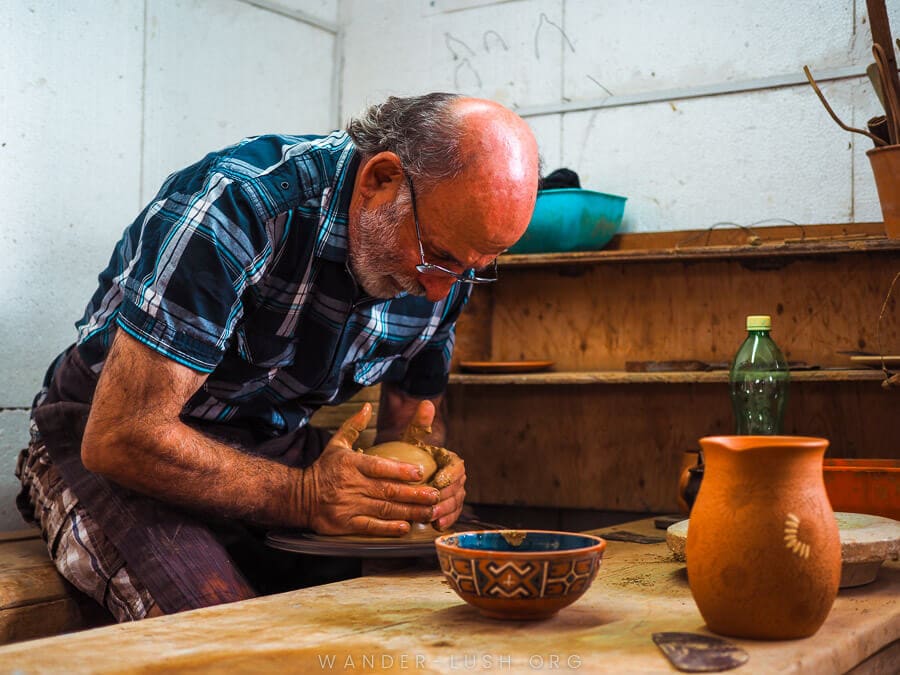
Speaking of talented craftspeople, there is no artist who’s better known or more respected around these parts than sculptor Robert Absandze.
You can find his distinctive red and black-smoked ceramics in shops all around town and on display in guesthouses, restaurants and other venues (including at Casa de Khasia and Folk House).
Along with his wife, Manana Kakulia, Robert runs a workshop-gallery in the family home near the Botanical Garden.
ORKOL Studio is open to the public and welcomes guests for tours and demonstrations led by Tsira Absandze, who works in the studio alongside her father.
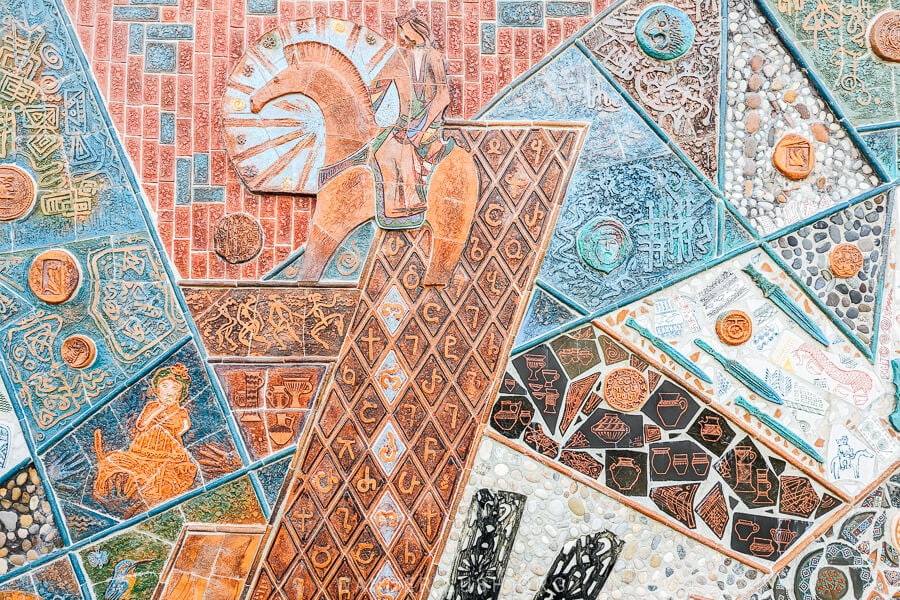
The front of the property houses a fine art gallery, where Robert displays some of the sculptures he’s created over the decades. Out back, there’s a huge working studio where ORKOL produces household ceramics – plates, jugs, cups and saucers, etc. – completely from scratch.
The process starts with making clay from earth gathered in nearby villages and ends with firing the ceramics in Robert’s homemade kiln.
If you’re lucky, he will get behind the wheel for a quick demonstration.
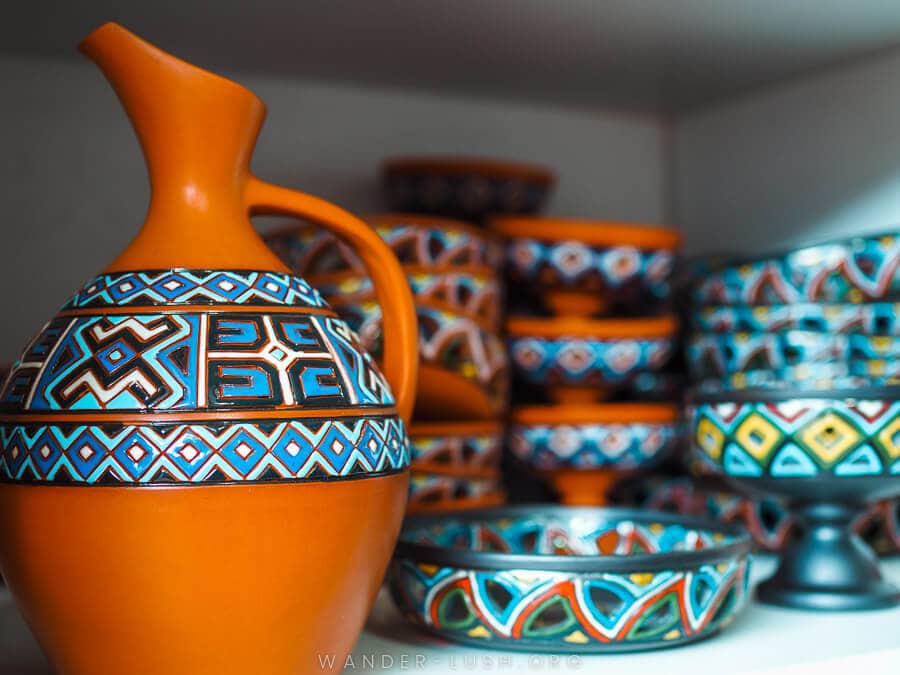
Final stop is the gift shop, where ORKOL’s full collection of beautifully hand-painted ceramics is on offer. We picked up a wine jug and a set of cups when we first visited. Now we have an entire shelf of our kitchen display cabinet filled with ORKOL goodies!
This is a great place to do your souvenir shopping and support local entrepreneurs in the process.
Learn more about ORKOL Studio and Robert’s work here.
- Opening hours: Daily from 9.30am (or by appointment) – message Tsira on Facebook to organise your visit
7. Wander down Zugdidi’s City Boulevard
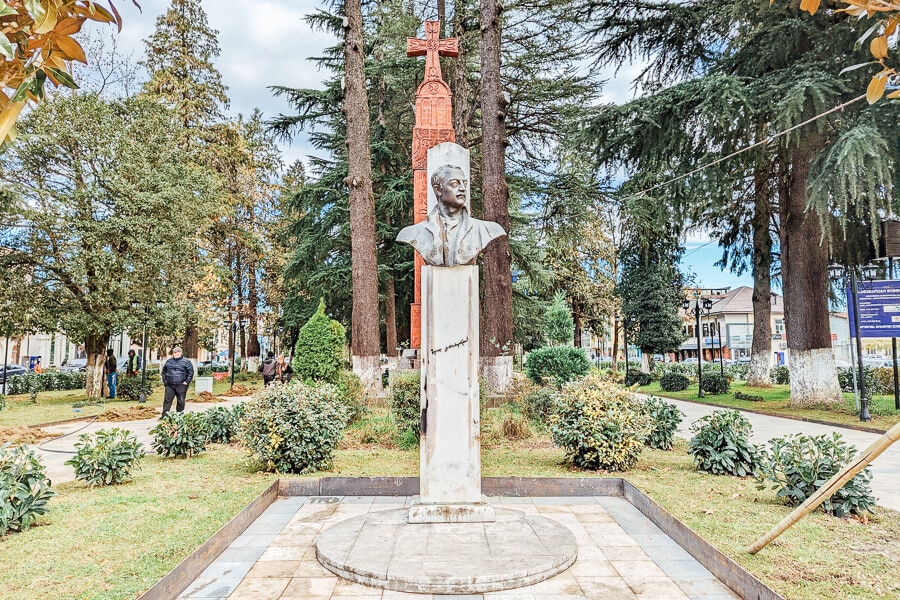
The centre of Zugdidi is small and leafy. I recommend taking a stroll all the way down the main street, known as City Boulevard, to Liberty Square and the fountain.
A long park cuts through the middle of the road and is lined with tall trees and park benches. A water channel (almost identical to the one in the Botanical Garden) cuts down the centre.
This whole area was recently restored.
On either side of the road, you’ll see Zugdidi’s strange mix of modern and historical architecture, including socialist apartment blocks alongside traditional Oda houses with fine carved wooden balconies.
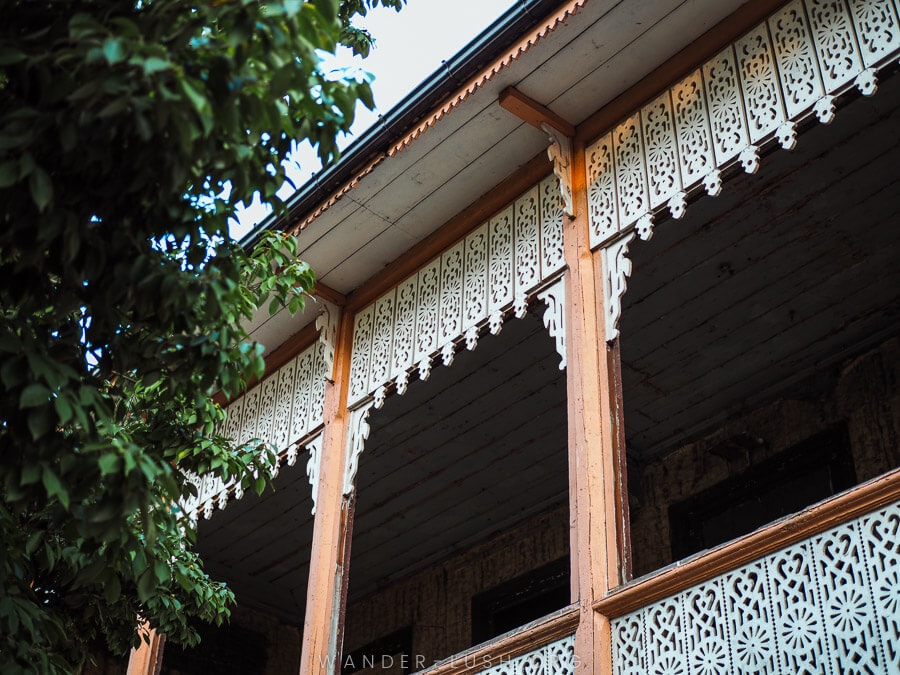
On a more practical note, most of Zugdidi’s supermarkets, pharmacies and shops are located on or around the main road.
8. Browse the mammoth Zugdidi Bazari
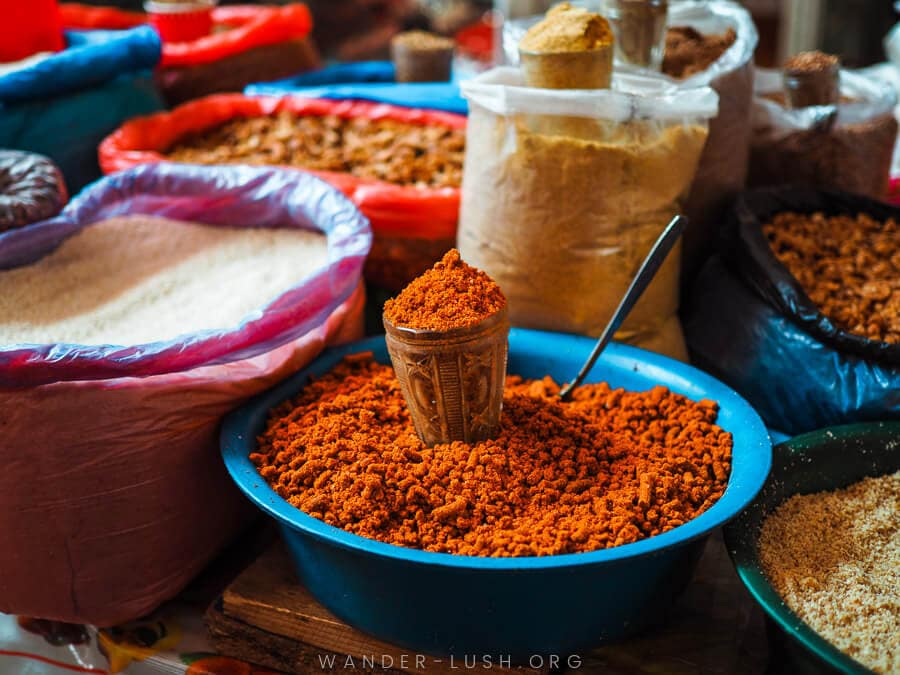
Every market in Georgia is worth visiting at least once in my opinion. Zugdidi’s Agrarian Market is one of the largest food markets I’ve seen in Georgia. It feels much bigger than even Tbilisi’s Dezerter Bazaar.
Located at the top of the main street near the river, it incorporates undercover and open-air sections. Stalls are mainly dedicated to fresh produce but everything and anything seems to be on offer. This is the only market where I have seen loose laundry powder for sale by the scoop!
You will also notice exchange desks inside the market where shoppers can trade rubles for lari – a reminder that some families travel back and fourth from Abkhazia to do their shopping.
A lot of stalls sell nothing but little containers of fiery red and deep green adjika. The quality here is second to none, so you’ll definitely want to pick up some of the wet spice paste or dry rub for a souvenir or a gift. Be sure to double-bag it and ideally place it in an air-tight container – otherwise the smell will infuse your entire bag and everything you own!
Set aside a good 30 minutes to wander through the bazaar. Mornings and weekends are best.
- Opening hours: Daily from 8am until late
9. Shop for adjika at Kera
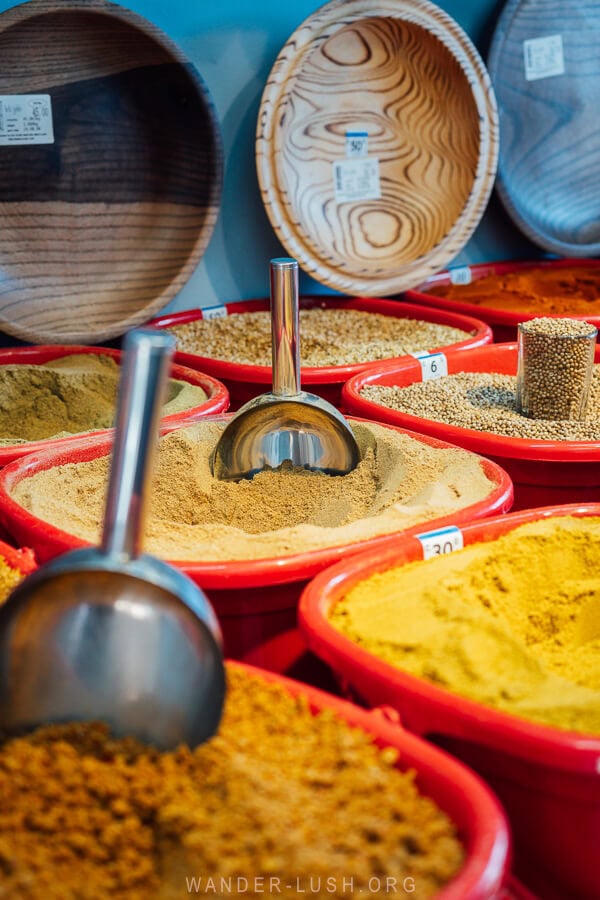
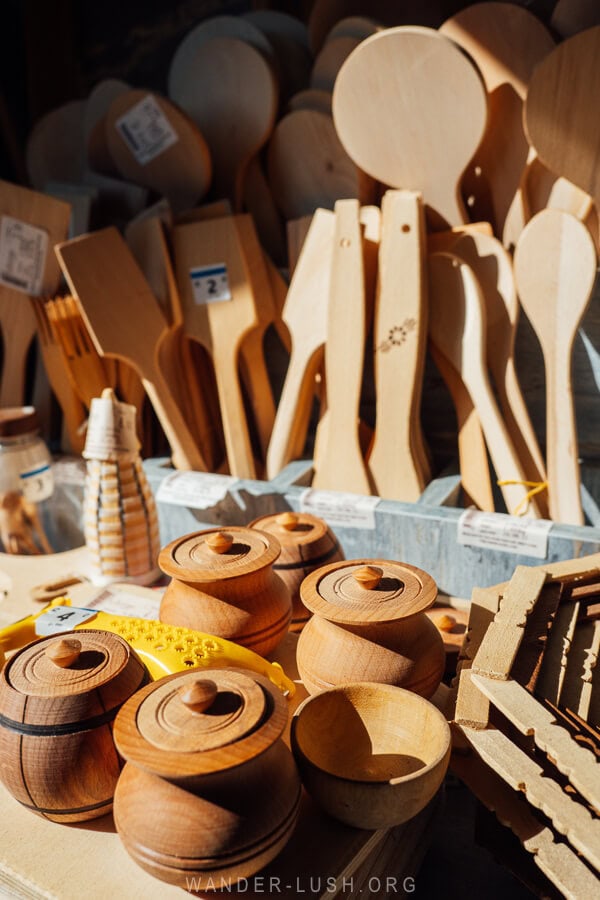
If the bazari feels overwhelming, this delightful little spice shop between the railway station and the river sells an excellent range of wet and dry adjika. Marigold, blue fenugreek, kondari (mountain oregano) and other Georgian herbs and spices are also available.
Everything is labelled and priced by the kilo. The shop is run by a friendly father and son, and the youngest member of the team, Dachi, speaks excellent English. Not only will he run you through all the spices, he will also tell you what recipes they are best for, and how to properly store them.
You can also find a nice selection of whittled wooden spoons, mortar and pestles, and other cute kitchen souvenirs here.
10. Visit Rukhi Castle for a view of Abkhazia
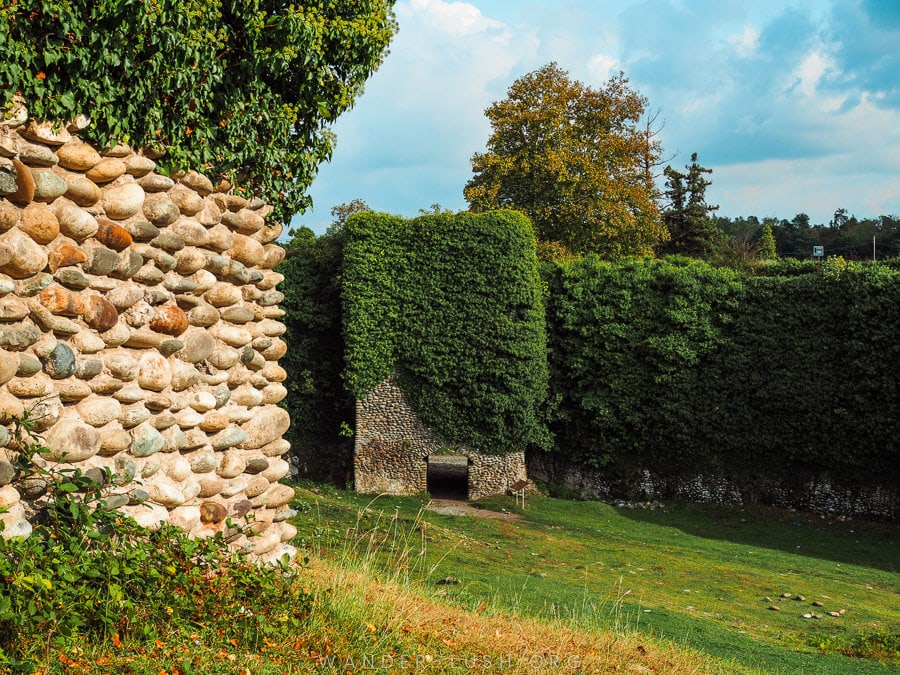
Rukhi village is located roughly 15 minutes by road from Zugdidi Even though it’s technically outside the city limits, it’s easy to reach and a worthwhile addition to your Zugdidi itinerary.
Budget around 1.5 hours to get to the fortress, have a look around, and get back. If you’re into mosaics, you could easily spend a half day in Rukhi: there are half a dozen wonderful pannos located right along the main road out from Zugdidi (see #12 on this list below).
The main attraction in the village is Rukhi Castle, a defensive fortification built by Levan Dadiani II in the mid-1600s. You can safely climb up the ivy-clad ruins to get a sweeping view across the Enguri river basin.
The heavily patrolled ‘border zone’ lies just 2.5km away from the fortress. In the far distance, you can just spot the Abkhazian flag flapping in the breeze.
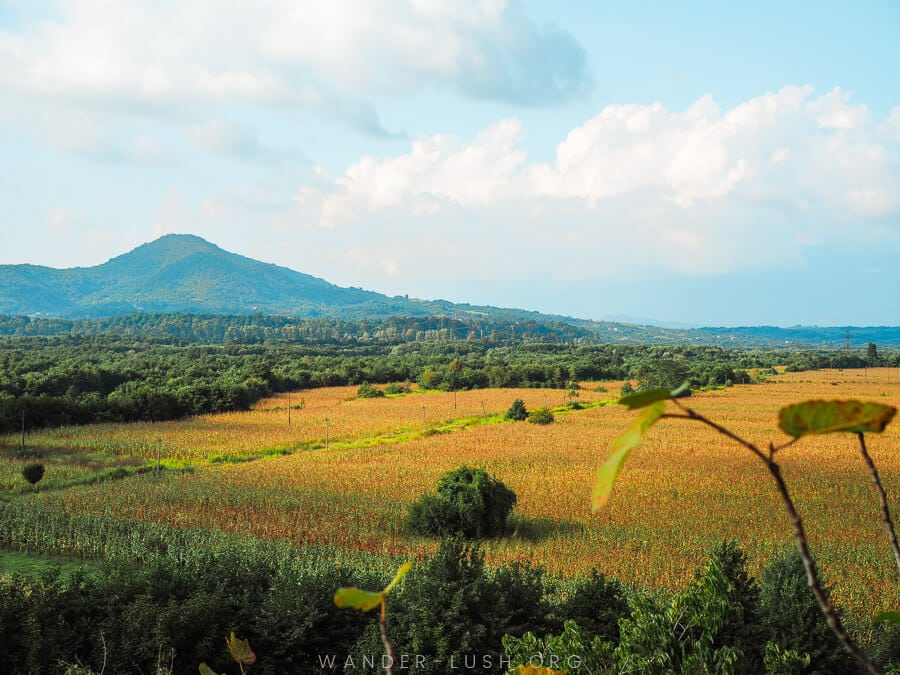
How to get to Rukhi from Zugdidi
Marshrutka vans bound for Rukhi village leave from outside Zugdidi Market, just to the left as you exit the undercover area. The van you want is no. 73. It runs in a constant loop, leaving every 20 minutes or so (with a pause in the middle of the day for lunch).
Tell the driver you want to go to Zugdidi Castle (Zugdid-sikhe) and he’ll drop you at the right place. It’s on the left just after the new hospital – you can’t miss it.
Coming back to Zugdidi, just stand on the road and hail a van travelling the opposite way. Chances are it’ll be the same driver and he’ll keep an eye out for you. We paid 1 GEL, although the official fare is probably less than that.
11. Find the UAZ graveyard (update: closed)
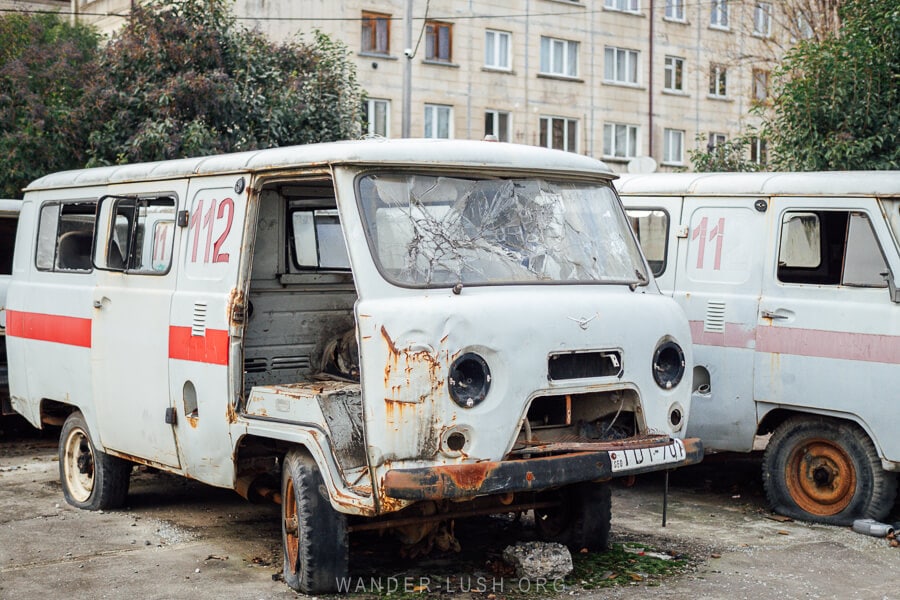
Important update: The UAZ ambulances have disappeared, apparently sold off for scrap. Unfortunately it is no longer possible to experience the UAZ Graveyard.
If you’re interested in Soviet history, you should also pay a visit to the Zugdidi Referral Hospital. There are remnants of another mosaic wall here, but the most interesting feature is a fleet of retired UAZ ambulances that live in the carpark.
There are 15 of these UAZ-452s – AKA Tabletkas or ‘pills’ in Russian – parked near the old hospital.
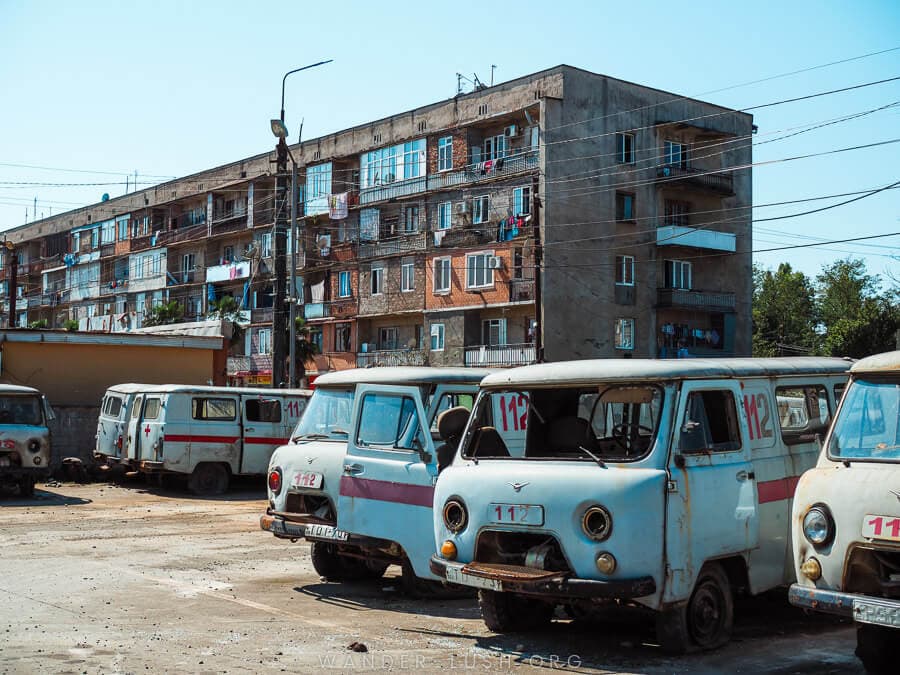
I was so fascinated by these old Soviet-era vehicles that I wrote a whole post about them. Here is everything you need to know about visiting the UAZ graveyard.
In early 2024, the ambulances were moved to a different area of the hospital and arranged in neat rows. When I went back to visit in autumn, the vehicles had completely disappeared. RIP!
12. Track down Zugdidi’s many Soviet-era mosaics
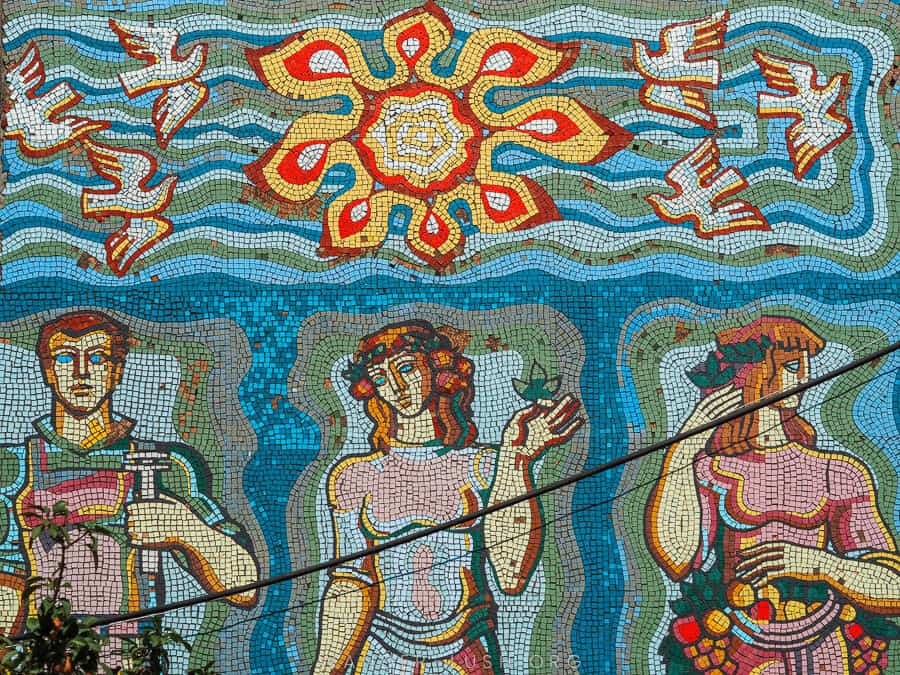
If you’re interested in Soviet-era mosaics, you’re going to love Samegrelo. Mainly erected on the facades of schools, factories and bus stops, each one is a work of art.
Our first road trip around Guria and Samegrelo reignited my love for these mosaics and I ended up tracking down a number of them along our route. I have since been back to complete the list by photographing all the mosaics in the vicinity of the city.
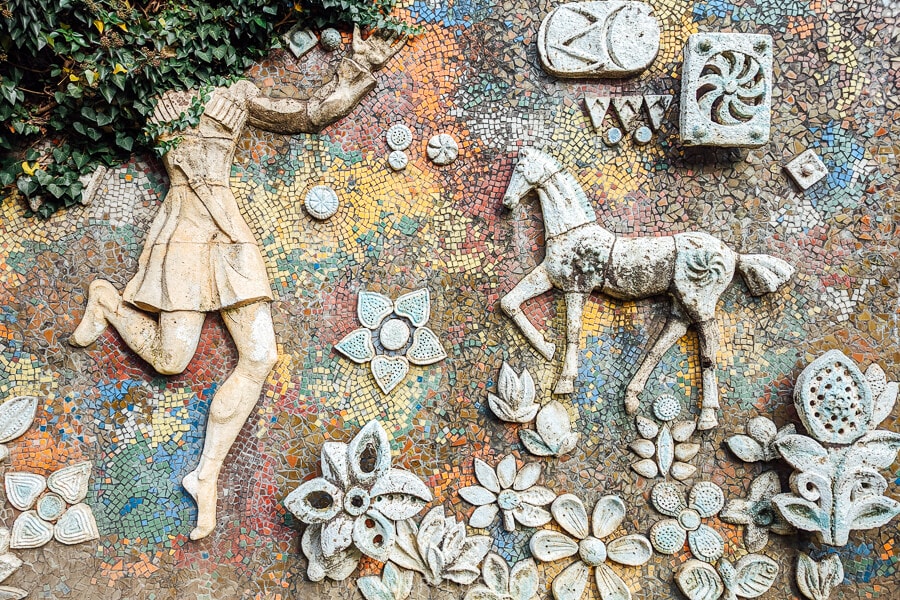
In the centre of the city, you will find a mosaic wall & fountain (pictured directly above). The artist Apolon Kharebava combined tile and bas-relief elements for an interesting three-dimensional composition. It decorates the National Drama Professional Theatre and is located close to Diaroni and ORKOL Studio.
The second more standard tile mosaic (pictured above) is located on the facade of a former industrial building in the southwest of the city. It depicts three figures of industry (a man dressed in overalls, a tea picker and a citrus harvester) standing beneath a radiant sun flanked by doves. It is located off the main highway in what is now a residential area.
On the opposite side of the road, a mosaic wall marks the entrance to the Zugdidi Referral Hospital – also the location of the former UAZ Graveyard.
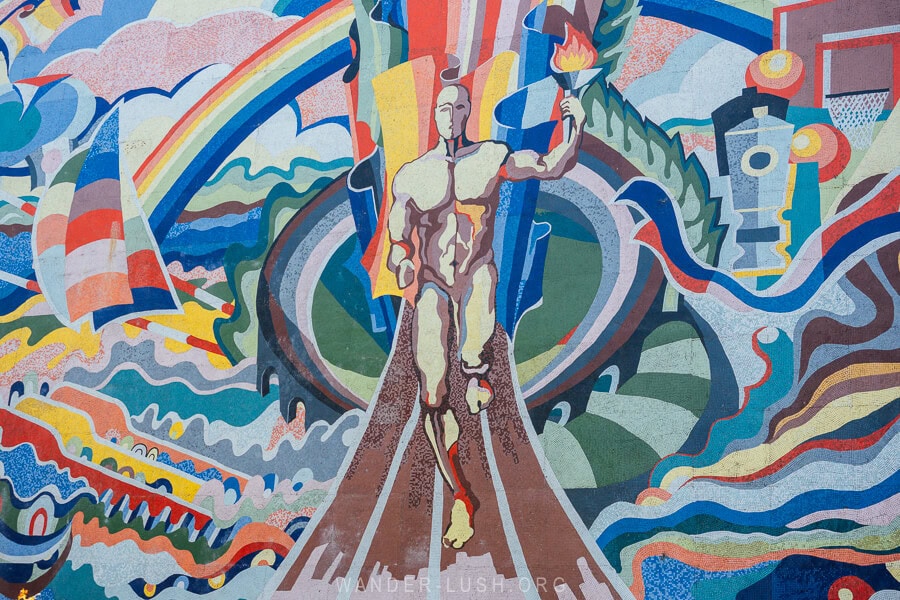
The most impressive mosaic in Zugdidi is definitely the large-scale panno that adorns the former sports complex on Janashia Street. It too was authored by Apolon Kharebava.
This mosaic is in tip-top condition. It depicts a central figure with rippling muscles running down an athletics track, flaming Olympic torch in hand. He is flanked by abstract symbols of different sports – sailing, basketball, tennis and even chess.
The former Palace of Sports is absolutely huge, with an indoor pool and a wood-panelled basketball court inside. It is unfortunately abandoned and derelict. There is another Apolon Kharebava work inside the building.
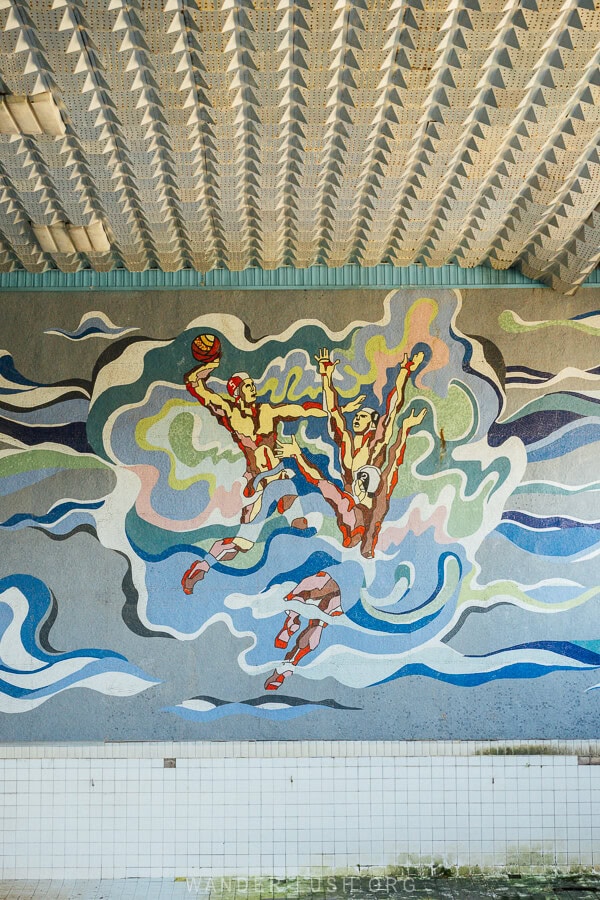
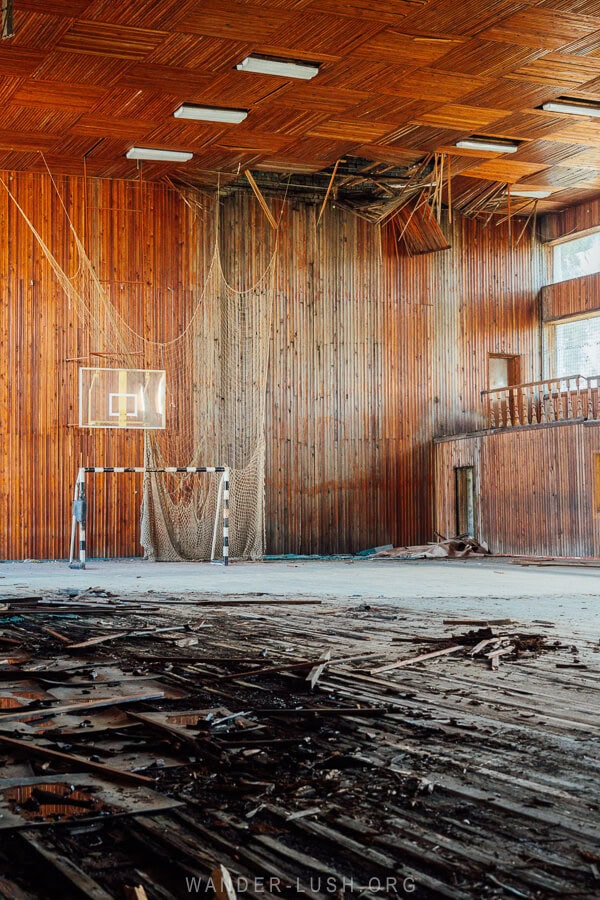
If you are taking the bus to Rukhi Castle, be sure to stop off along the way to photograph the colourful mosaics that line the highway. There are half a dozen mosaic-clad bus stops, walls and former factory facades in total.
My favourite is the mosaic on the former Rukhi Palace of Culture, created in the 1980s by Avtandil Mindiashvili. I adore the rich colours and the swirled background. The photo below was taken a few years ago – this mosaic has since been expertly restored.
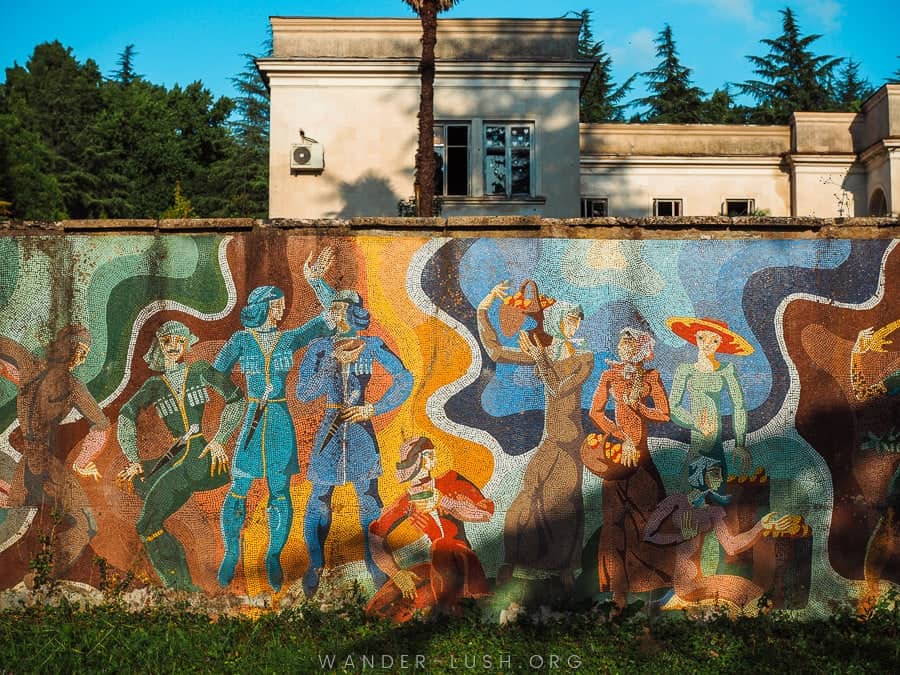
Directly opposite, there are two more large-scale mosaics on the local school.
Also pay attention to the apartment buildings in central Zugdidi (near Diaroni) – each one is covered from head to toe in tiny mosaic tiles that shimmer in the afternoon sun.
13. More mosaics & Culture Houses in Ingiri & Kakhati
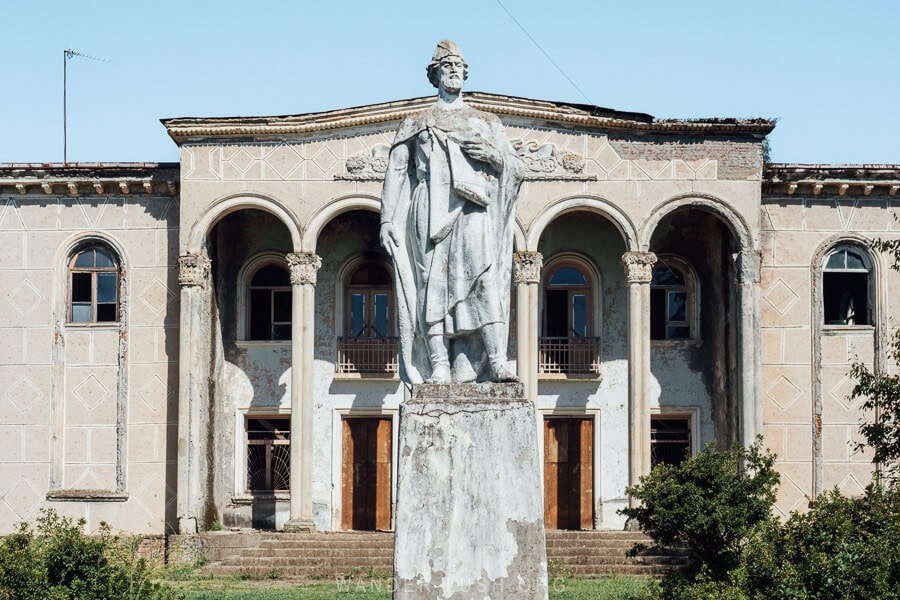
Heading in the opposite direction from Rukhi, south-west of Zugdidi towards Anaklia (also see #14 on this list below), there are plenty more Soviet-era treasures in the villages of Ingiri and Kakhati. This area was used heavily for agriculture, thus the high concentration of Culture Houses, cooperatives and processing factories.
In Ingiri, there is an impressive Palace of Culture (pictured above) with a statue of Shota Rustaveli standing out front. The theatre and top-floor offices are all completely ruined, but you can still get a feel for the former grandeur in the fragments of ceiling paintings, inlay floors and stucco work that remain in-tact.
We encountered a couple of intruders when we last visited.
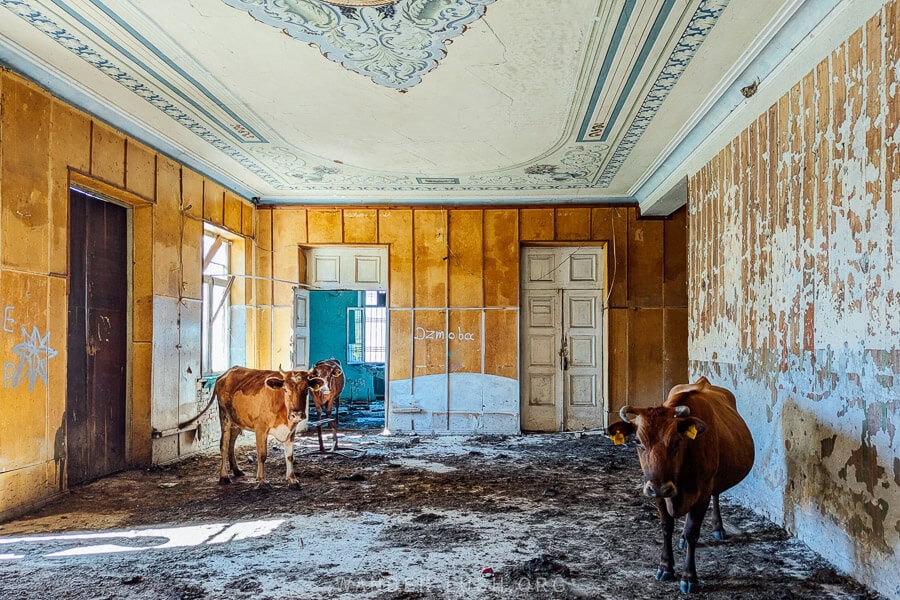
The former Ingiri tea cooperative farm has several noteworthy elements. The entrance is marked by two stone sculptures, one that bares the name of the cooperative (stamped with an Order of Lenin), and another that depicts tea pickers.
The first building is a gorgeous two-storey rotunda-like design with high arches flanked by tall palm trees (pictured below). It reminds me a lot of the old Tropical Plants Institute in Guria.
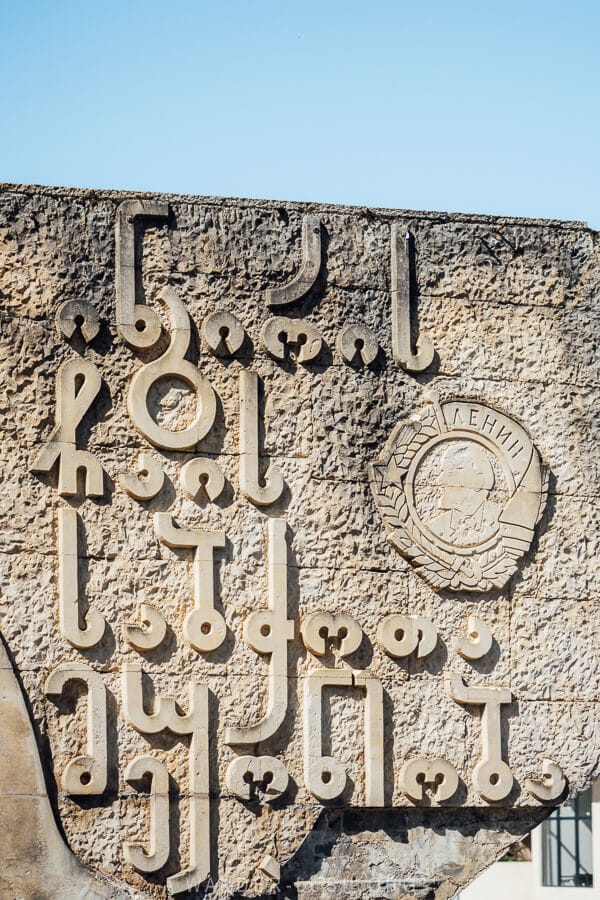
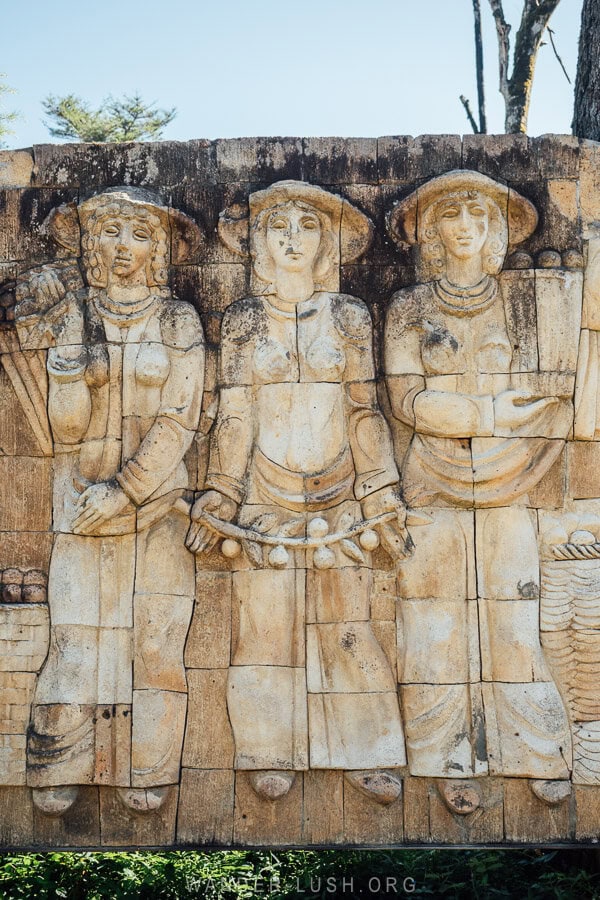
Deeper inside the complex, there is a very large fountain clad in mosaics depicting dolphins, fish and deep sea divers. It appears that people are living inside several of the old buildings in this area. The cantilevered concrete building immediately to the east of the fountain is particularly interesting.
Adjacent to the fountain, another building – perhaps the old Palace of Culture – has been restored and is now a restaurant called Kingdom of Kolkheti.
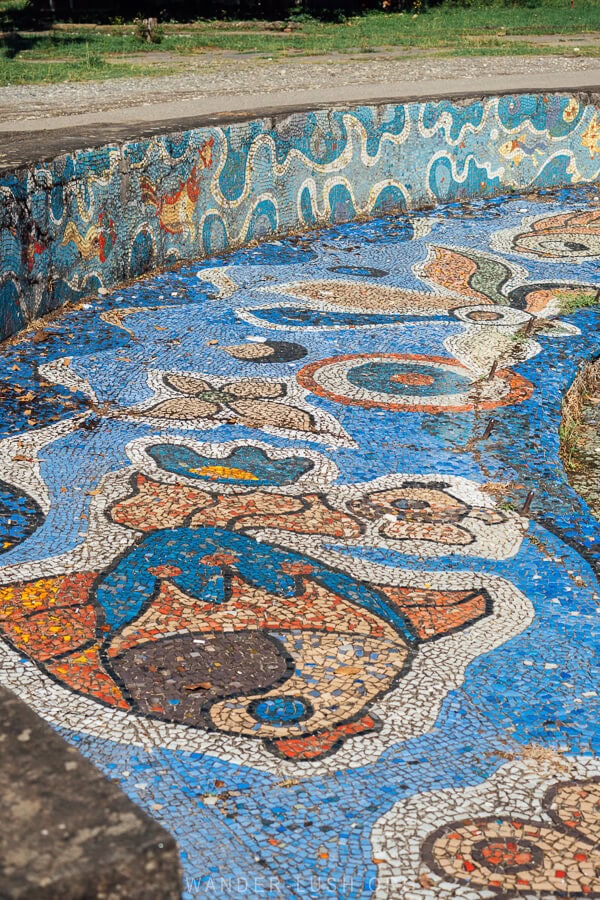
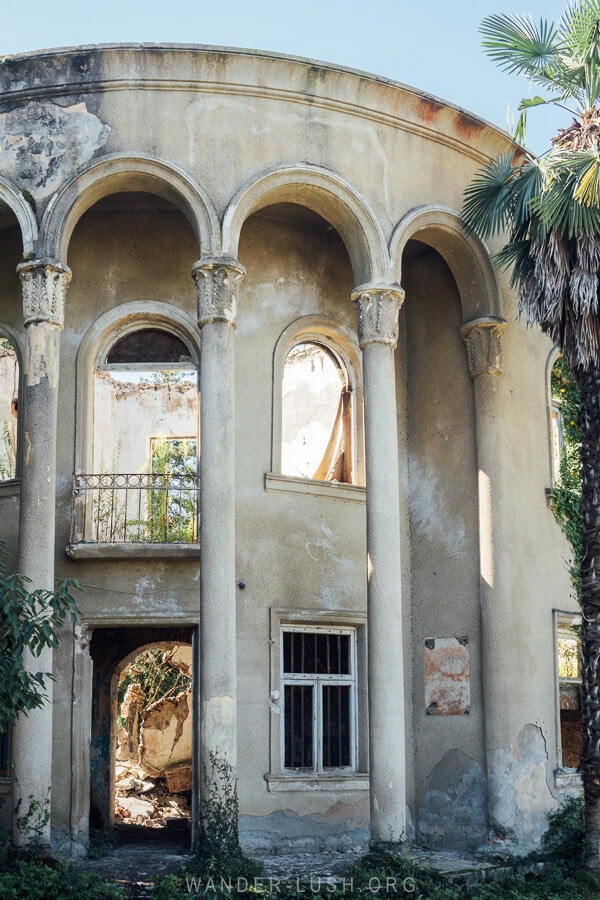
Down the road in Kakhati, there are three more mosaics. The first is a badly damaged panel that runs along the top of the facade of a former tea factory.
Kakhati’s First Public School sports two vivid vertical mosaics that are very similar to the ones at the school in Rukhi. The left-hand composition depicts students and teachers – on the bottom right, a father and son hold a copy of Deda Ena (‘Mother Language’), a book written by Iakob Gogebashvili in 1876 that is still used as part of the Georgian school curriculum to this day.
On the opposite side of the building, the mosaic shows children playing different sports. On my visit, I met the school principal and she told me that this damaged panno would soon be restored.
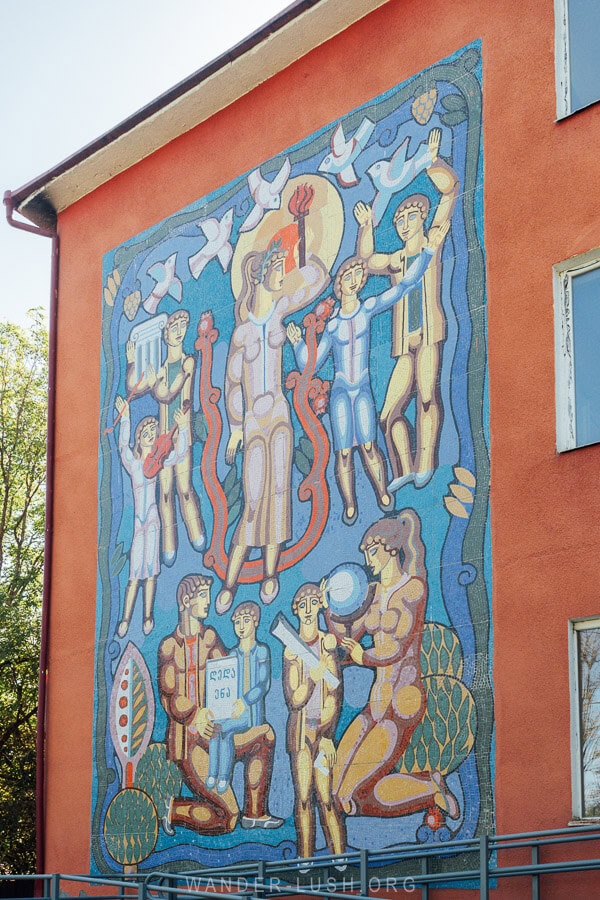
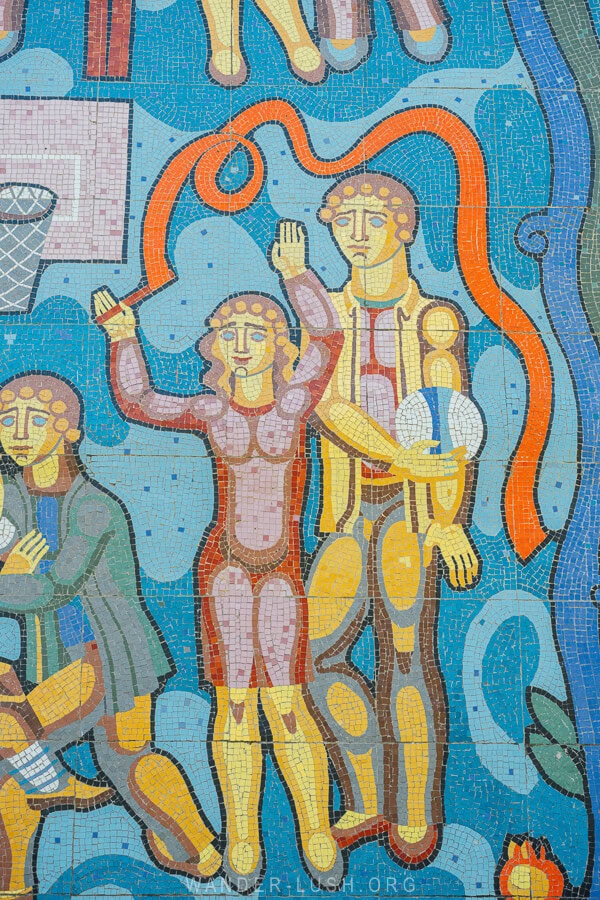
The bus shelter just down the road has a similar colourscheme and identical depictions of shrubs and fruit trees.
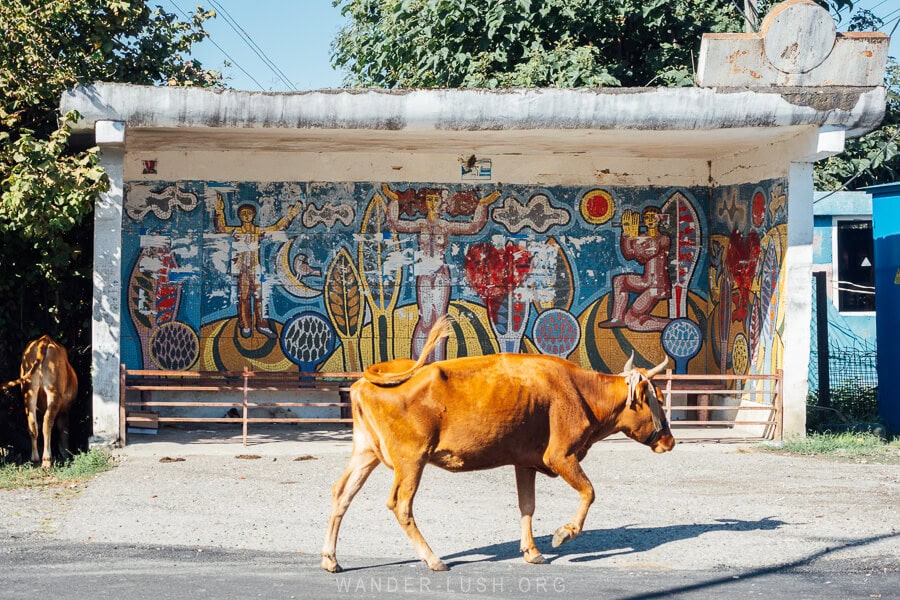
As far as I know, the author of these mosaics is unknown – but the same artist must be responsible for both the bus shelter and the school.
14. Spend an afternoon in Anaklia, Samegrelo’s surreal Black Sea resort
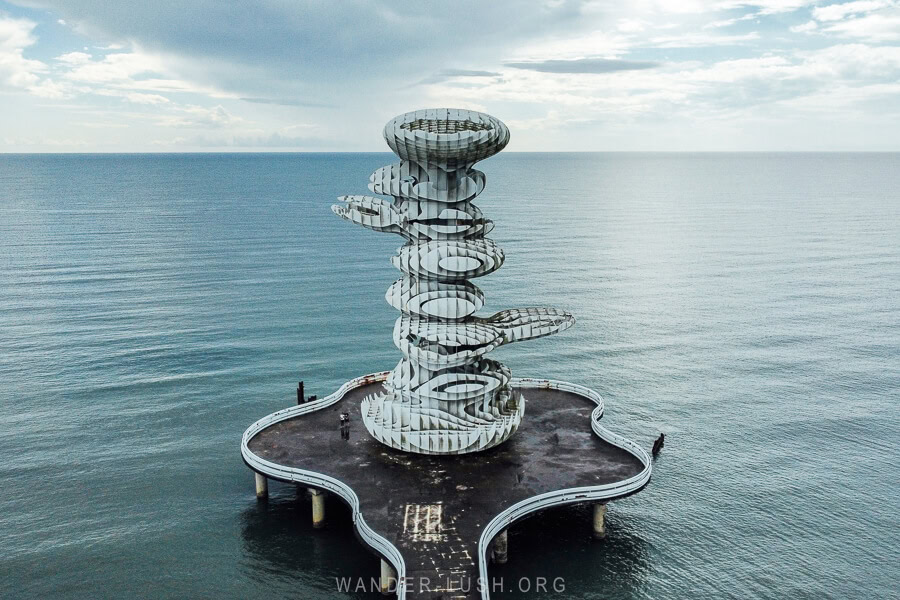
Samegrelo’s Black Sea coast and the resorts of Anaklia and Ganmukhuri are located 45 minutes’ drive west of Zugdidi.
The beaches are much nicer here than down south in Batumi (the sand is finer and the water is cleaner). But it’s not just beachgoers that will enjoy this Zugdidi side trip – Anaklia is a playground for photographers and urbexers.
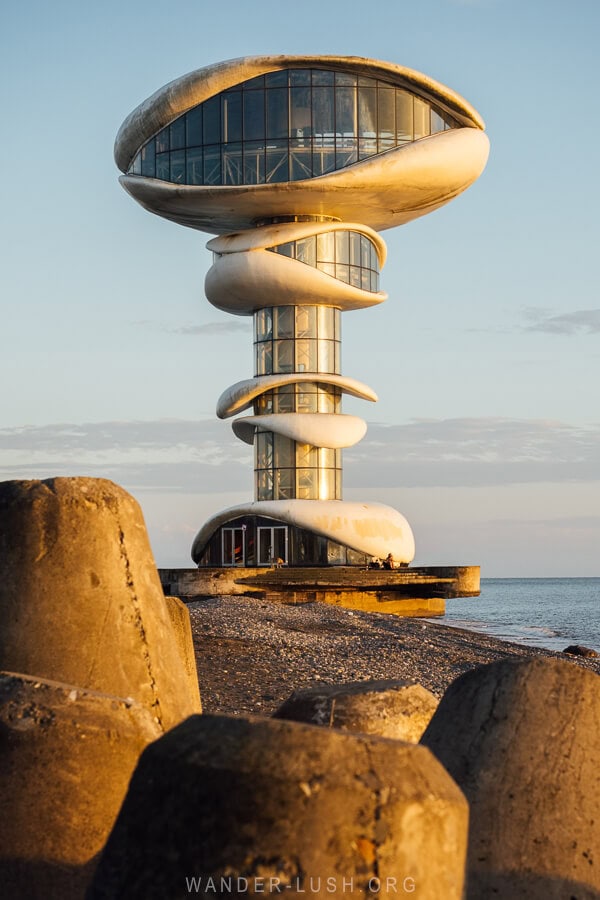
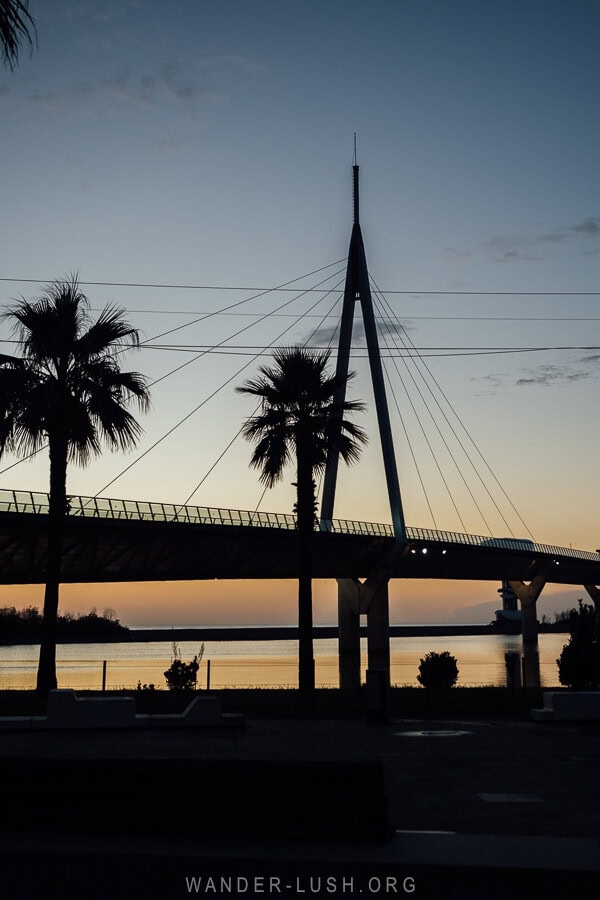
Anaklia is filled with half-finished hotels and abandoned buildings. Two peculiar structures – a sculptural complex and an observation deck tower – sit empty on the shoreline.
A 505-metre-long wooden footbridge – one of the longest pedestrian bridges in Europe – spans the mouth of the Enguri River, connecting Anaklia to Ganmukhuri and the last beaches on Georgian territory before the Abkhazia demarkation line.
Anaklia is slated to be developed into Georgia’s first deep-water port. The resort has long had the atmosphere of a place in limbo, and it might be your last chance to see Anaklia before it changes forever.
For more things to do and details on how to get to Anaklia from Zugdidi, see my dedicated Anaklia guide.
15. Visit abandoned sanatoriums and synagogues in Khobi, Abasha, Menji & Sujuna
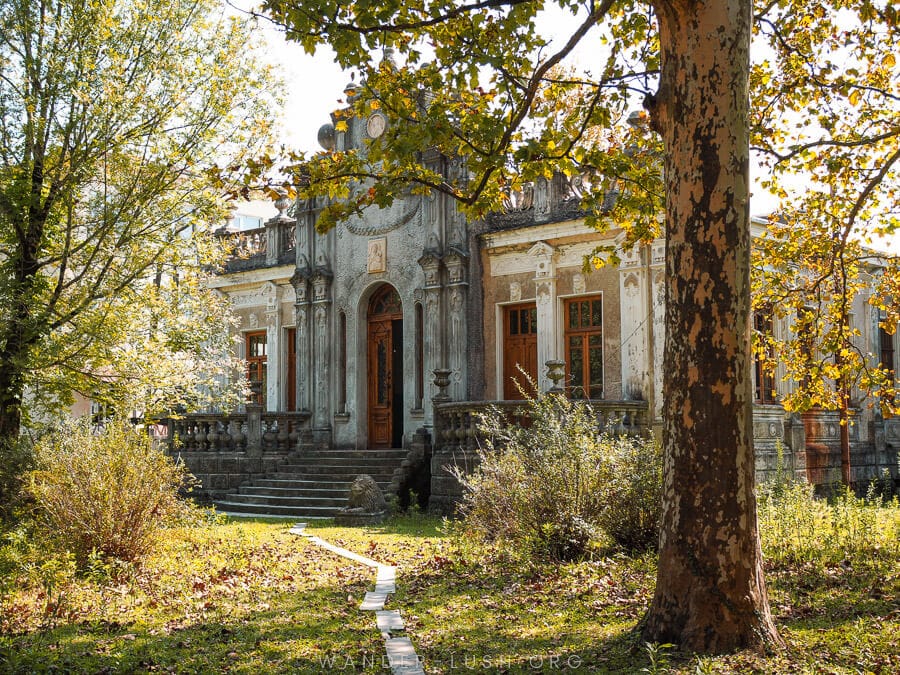
Another day trip idea is to travel to the south-eastern part of Samegrelo. The villages of Khobi and Sujuna are home to exquisite monasteries, Sovietised palaces and abandoned sanatoriums, while the larger Megrelian cities of Senaki, Khobi and Abasha have mosaics and Soviet-era architecture aplenty.
Menji is a much smaller version of Tskaltubo, with three completely abandoned sanatoriums. The main spa has an incredible domed roof with decorative friezes and much of its moulding still intact.
The village of Sujuna near Abasha was once a thriving merchant centre with connections to Poti via the Tsudgari River.
Here, you can visit the Akaki Khoshtaria House-Museum (pictured above), an Italian Renaissance-style residence designed in 1915 by European architects for the Georgian philanthropist. Also in Sujuna, there is a small abandoned synagogue and the beautiful St. George’s Cathedral.
I often refer to the road between Zugdidi and Kutaisi through Senaki and Abasha as the ‘Mosaic Route’ because of the abundance of Soviet-era monuments you see along the way.
I am currently working on a full guide to this part of Georgia that I will share soon.
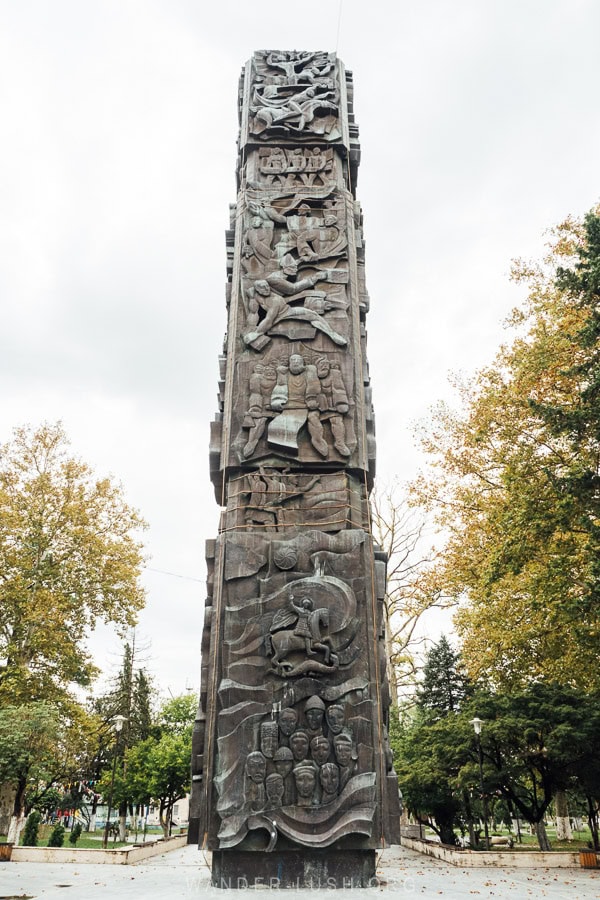
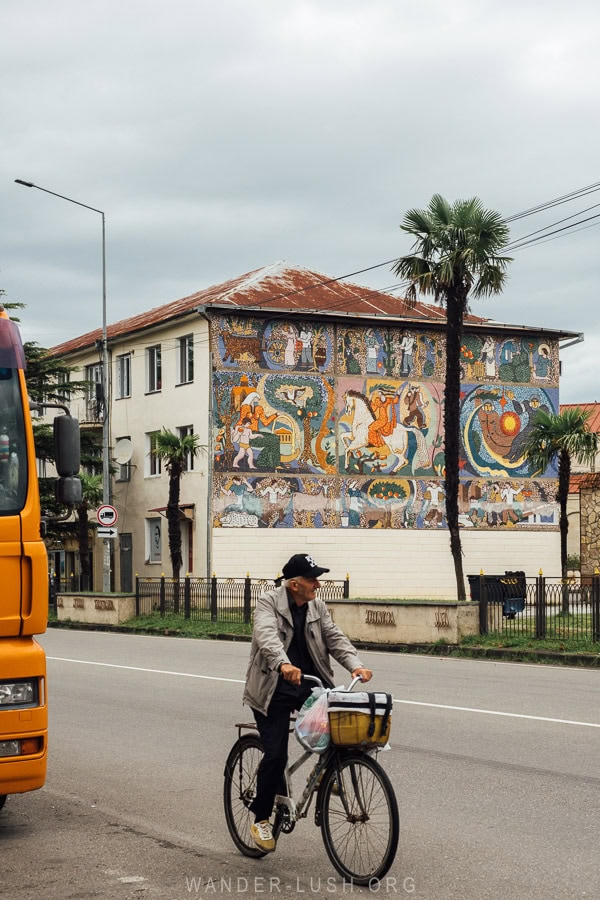
If you are driving to Zugdidi from Kutaisi, you can take the Mosaic Route there and visit all of these places along the way.
Another option is to make a day trip from Zugdidi. If you don’t have your own car, I recommend hiring a local driver. Here is an example itinerary I made on GoTrip.
16. Meet the local priest reviving Megrelian horse traditions
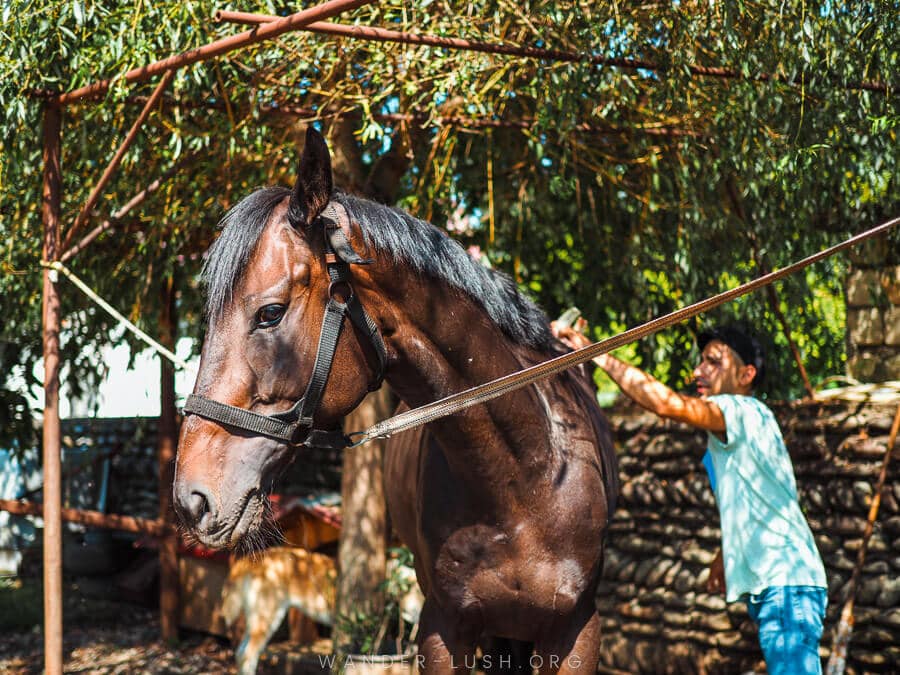
As with Pankisi’s Kist community, horses have long been an integral part of Megrelian culture. After the collapse of the Soviet Union, horse rearing traditions all but disappeared from this part of Georgia as the racing industry was wiped out.
Just off the highway before you reach Zugdidi, one man is doing his best to revive those traditions. A priest by profession, Presbyter Ekhvaia was gifted his first horse a decade ago and fell in love. He and his two sons, Saba and Mate, sold their apartment and used the funds to build a stable at the back of the church.
As well as training horses for racing, Horse Club Khareba offers riding lessons and free horse therapy to children in the community who suffer from spinal injuries and other disabilities.
Tourists can visit for a tour of the stables with Saba. They can also organise horse treks into the nearby mountains if that’s of interest.
17. Sunset drinks in Zugdidi on the roof of the Garden Palace Hotel
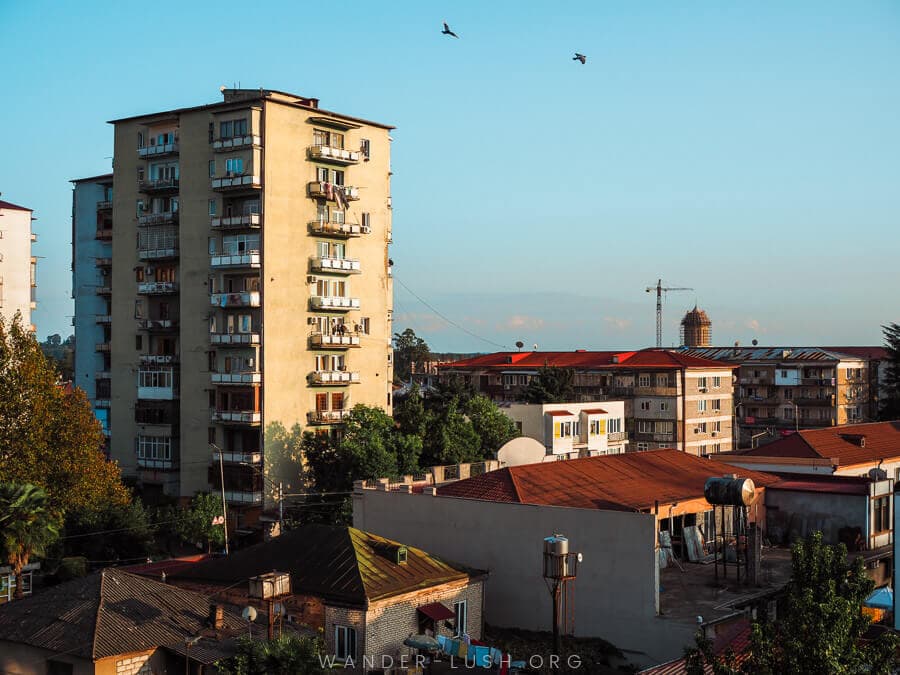
Who knew that Zugdidi has its own rooftop bar!? Sure, it’s only five stories up, but Terrace Restaurant atop the Garden Palace Hotel is still the best place in the city for a sundowner.
The balcony offers views over the skate park and Botanical Garden on one side and the apartment blocks in the city centre on the other. On a clear day you can see all the way to the mountains of Svaneti.
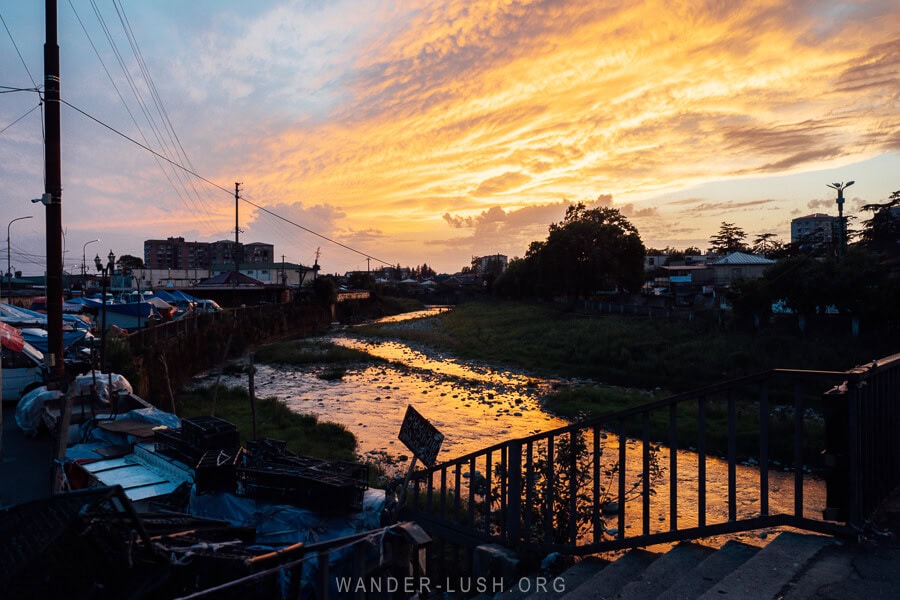
Admittedly we only came for the view, but we were pleasantly surprised by the quality of food here. Prices are very reasonable and they have a good range of Western and Georgian meals (craving something different, we both ordered a chicken Schnitzel – I highly recommend it) along with wine, beer and cocktails.
Where to eat & drink in Zugdidi: Best Zugdidi restaurants & cafes
Sadly, two of Zugdidi’s top venues, El Barco (a restaurant set up to support Abkhaz IDPs) and Art House (a popular bar-cafe) closed in 2020.
But there are plenty of other places to eat and drink in Zugdidi, including a few recent openings.
Top choice: Diaroni
A local favourite, Diaroni is often name-checked as the best place in Zugdidi to try Megrelian cuisine. There is a large indoor dining room and in summer, an outdoor terrace. Staff are extremely friendly and prices are good.
Refer to #4 on my list of things to do in Zugdidi for recommendations on what to order.
Folk House
Another great place to sample Megrelian delicacies, at Folk House you can also watch and learn how certain dishes are made. Refer to #5 on my list above for more information about planning a visit.
The Host – Mendzel
The Host is a solid choice for both local Megrelian and classic Georgian dishes. The castle-like interior of the restaurant, with stained-glass windows and artefact displays, is pretty impressive.
We enjoyed the Dadiani khachapuri, the cucumber and tomato salad and the khinkali.
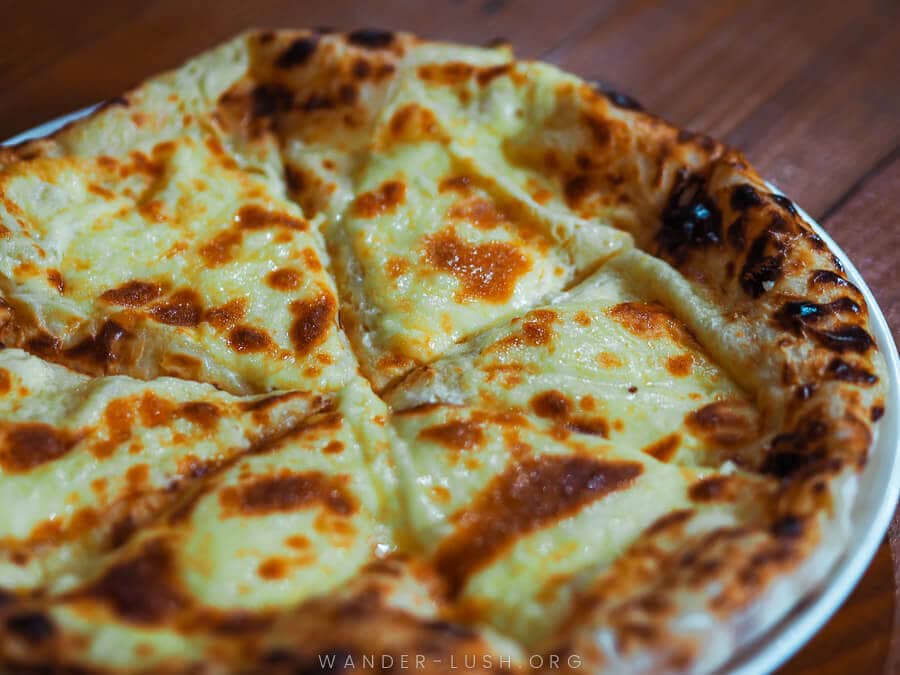
Kolkhuri
This popular cafe is excellent for a quick bite or breakfast on the go. As well as pastries and coffee, there are hot and cold dishes served cafeteria-style.
Cafe Botanico
This cafe inside the Zugdidi Botanical Garden serves a mix of Georgian and European dishes along with Italian coffee and Georgian wine. On summer evenings, the cafe hosts DJs.
Tamtini Bakery
Tamtini is a cute patisserie-cafe in the centre of town that serves very good barista coffee. The cake cabinet is replete with fruit tarts, tortes, medoki honey cake, and other typical Georgian sweets.
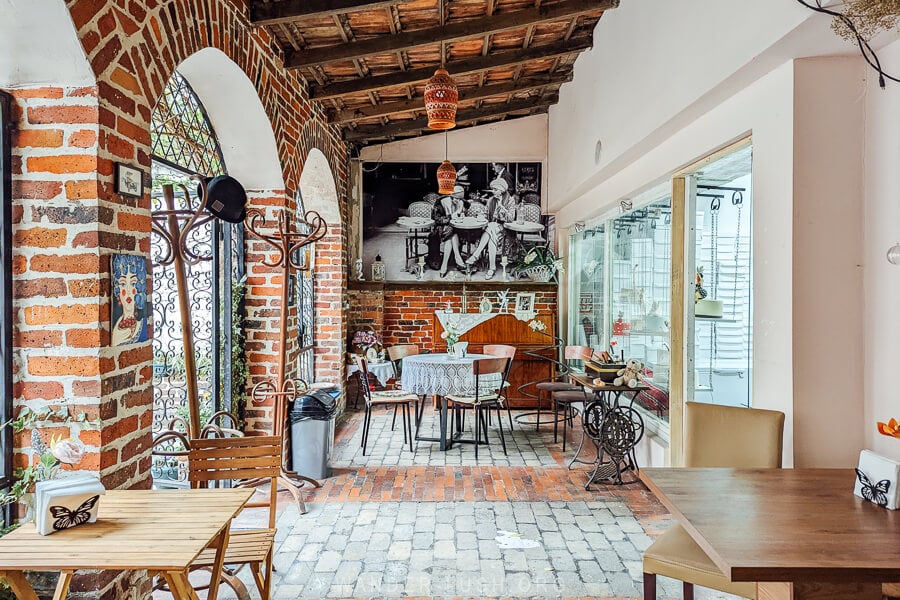
Pancake House
Pancake House is ideal for a quick meal or a sweet after-dinner treat. They specialise in thin crepe-style pancakes lathered with Nutella and topped with seasonal fruit. Waffles and American pancakes are also on the menu, along with savoury dishes including chicken shawarma and pelmeni.
They serve coffee and a range of easy eats including pepperoni pizza, which is always a popular choice in Zugdidi. The outdoor balcony seating overlooking the treetops is just lovely.
What to do in Zugdidi in 24 hours: Suggested 1 day Zugdidi itinerary
While I recommend staying for a couple of nights, here’s an example of what you could fit into a day in Zugdidi.
Morning: Walk through the Botanical Garden, stopping for coffee at Tamtini on the way, before arriving at the Palace Museum for a guided tour at 10am.
Peek inside the Niko Dadiani Museum, then walk around the side of the park to ORKOL Studio. Continue a few short blocks to Diaroni and order a Megrelian feast for lunch.
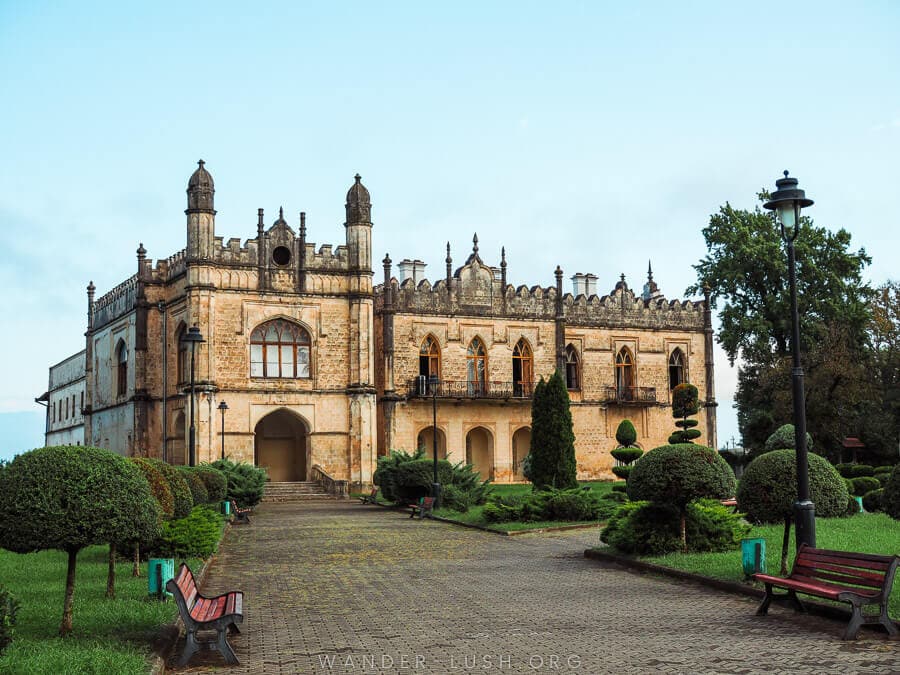
Afternoon: If you made a purchase at ORKOL, drop off your bags at your accommodation before walking down Zugdidi’s main street, stopping for an afternoon snack along the way. Wander through the produce market, then head out front to pick up a marshrutka to Rukhi. Climb the castle ruins for a view and if it interests you, stop on the way back to view the mosaics located in the town along the main highway.
Evening: Return to Zugdidi for a sunset drink at Terrace. Finish the day with dinner, local wine and a serenade from Besiki at Folk House.
Explore more of Samegrelo with these day trips from Zugdidi
Some of these day trips from Zugdidi can be done using marshrutka vans from the main bus station near the railway station or from outside the market (check times and departure points with your guesthouse or at Tourist Information).
- Sisa Tura Ethno Village (20 minutes from Zugdidi): Experience Megrelian cooking masterclasses, music and other folk traditions at this incredible ethno village created by Marika Todua.
- Enguri Dam (1 hour from Zugdidi): Scenic views and boat trips on the world’s second-highest concrete arch dam. Enguri is located on the way to Mestia.
- Poti (1.25 hours from Zugdidi): Home of Georgia’s biggest port, Poti or ‘Little Paris’ has a historic lighthouse, heritage architecture and street art, and access to the incredible Kolkheti National Park.
- Tsaishi Cathedral (20 minutes from Zugdidi): Prominent 6th-century church that serves as the seat for Zugdidi’s Diocese.
- Tsalenjikha Cathedral (30 minutes from Zugdidi): Gorgeous 12th-century church with stone arcades and unique Byzantine frescoes.
- Chateau Chakudashi (30 minutes from Zugdidi): The Dadiani’s former summer palace and hunting grounds offers panoramic views to Abkhazia. Princess Veronique, a descendent of the family, lives on the property and welcomes guests.
- Nokalakevi (1.25 hours from Zugdidi): Linked to the legend of Jason and the Argonauts, there’s a large open-air Archaeological Museum plus natural hot springs nearby.
- Martvili (1.5 hours from Zugdidi): For Martvili Canyon, the lesser-known Balda Canyon and the famous Martvili Monastery. Instead of visiting as a day trip, consider spending a night or two at the wonderful Karma Hostel.
How to get to Zugdidi
By train
The most comfortable way to travel between Tbilisi and Zugdidi is by train. The journey takes 6 hours. You can also use this service to travel to/from Kutaisi (via Rioni Station; 2.5 hours) or Gori (5 hours).
The once-daily train departs from Tbilisi’s Central Station in the morning and arrives in Zugdidi in the early afternoon. The same train departs Zugdidi at around 5pm and arrives back in Tbilisi before midnight.
Previously, there was also a slower night train from Tbilisi to Zugdidi, but it has been suspended since 2020 and there are no plans to restart the service. There is no longer a night train to Zugdidi.
Check train times in English here, and buy tickets for any route online via TKT.GE or 12Go.
Zugdidi Railway Station is located 2 km from the centre of town (see the exact location here). A taxi to or from the centre should cost around 5-7 GEL.
→ For more tips, see my guide to the Tbilisi Zugdidi train
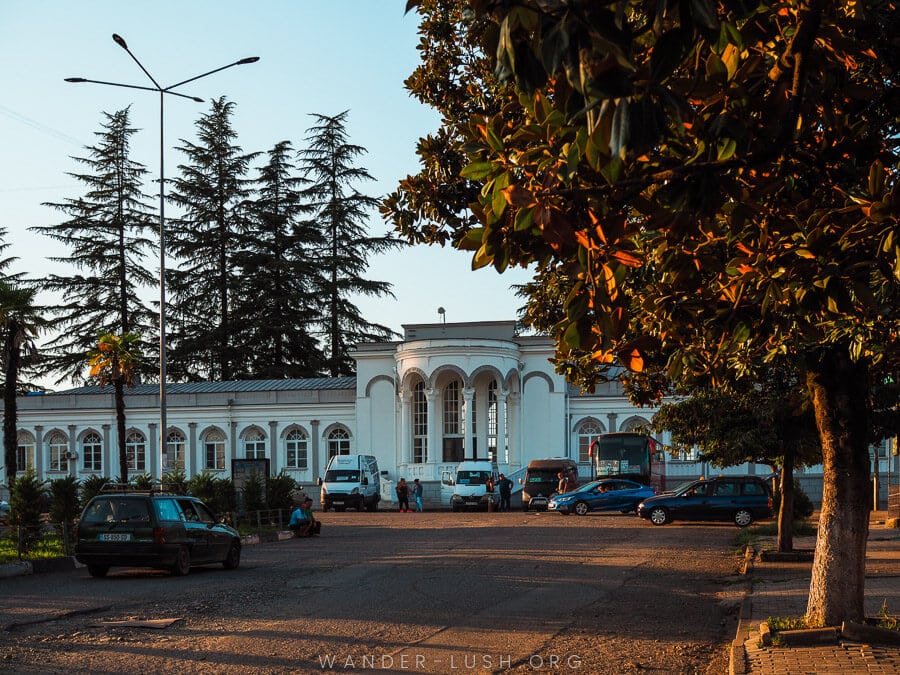
By marshrutka or bus
There are regular marshrutka minivans to Zugdidi from every other major city in Georgia.
Vans depart from Tbilisi every hour starting from 9am from Okriba (Didube) Station and terminate at Zugdidi’s main bus terminal near the railway station. Tickets cost 35 GEL, and travel time is 5.5-6 hours.
For the return leg, marshrutka vans keep to the same schedule, departing Zugdidi every 60-90 minutes from 7am until late. There is a cash desk inside Zugdidi Railway Station where you can buy tickets. Most drivers leave from the parking area in front of the railway or from the small bus station adjacent.
Alternatively, OmniBus runs large coach buses between Tbilisi’s Ortachala Station and Zugdidi. There is a day bus departing Tbilisi at midday plus a night bus departing Tbilisi at midnight. Travel time is 6 hours. Tickets cost 30 GEL and can be purchased online through OmniBus. In Zugdidi, coaches arrive/depart from the small bus station near the train.
If you are coming from Kutaisi, the best option is to take the train from Rioni Station (see above). Otherwise, minivans depart from Kutaisi’s Central Bus Station every 30-60 minutes throughout the day, starting from as early as 6.30am in summer through to 6pm. Tickets cost around 10 GEL and travel time is roughly 2.5 hours.
From Batumi, vans depart from the Central Bus Station throughout the day. The fare is 25 GEL, and travel time is roughly 3 hours.
By taxi
The most efficient way to travel to Zugdidi is with a private driver. No matter your point of origin, there are plenty of things to see and do around Zugdidi – so if you have time, you can make a day of it and do lots of sightseeing along the way.
I recommend using GoTrip to organise a private transfer to/from Zugdidi. This is a great option if you have lots of luggage or you want to make pitstops for mosaics, museums and hot springs.
How to move around
The central part of Zugdidi (including the palace complex and restaurant area) is small enough to navigate on foot. Bolt app is available in Zugdidi (albeit with a small fleet of drivers), and the alternative app Maxim also works.
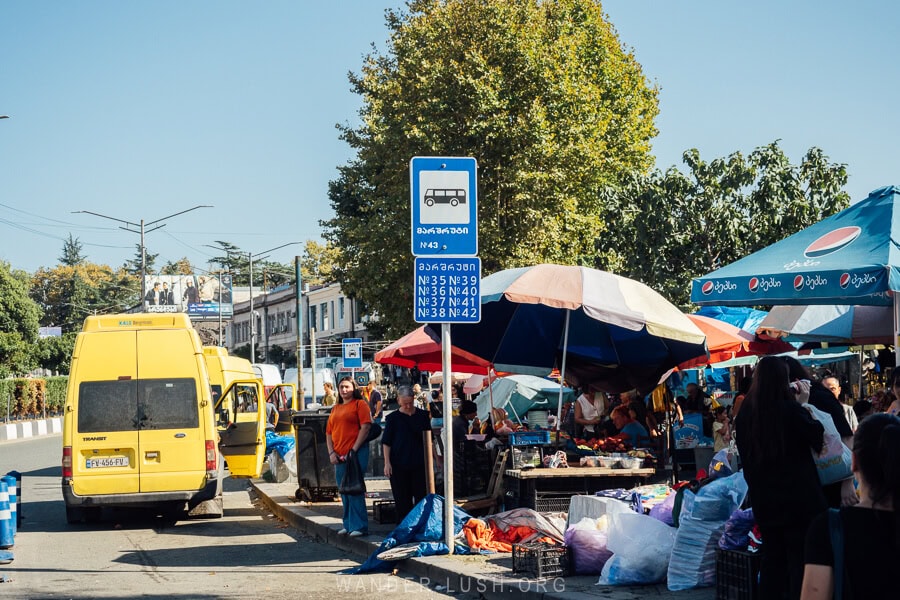
Other attractions that are close by, including Rukhi Castle and Anaklia, can be reached by local bus, as described above.
For anything further afield, I recommend hiring a car and driver for the day. Use GoTrip for popular routes, or enquire at your guesthouse for daily rates for more complex itineraries.
Onward travel from Zugdidi to Mestia
Many people choose to spend a day or two in Zugdidi before heading up to Mestia and Svaneti. Transport to Svaneti runs year-round, with connections most readily available in the summer months. Vans are less frequent in the off-season (October to May), but there should still be at least one service per day.
In the morning, marshrutka vans leave from a carpark close to the river (see the exact location here). The official departure time is 10am, but drivers only go when the van is full, so don’t be surprised if you have to wait. In the afternoon, drivers wait to meet passengers from the Tbilisi train, which gets in at 2.20pm. You can find them idling in the train station carpark at this location.
The fare to Mestia is 35-40 GEL. The journey by marshrutka takes around 3.5-4 hours with at least one rest stop along the way.
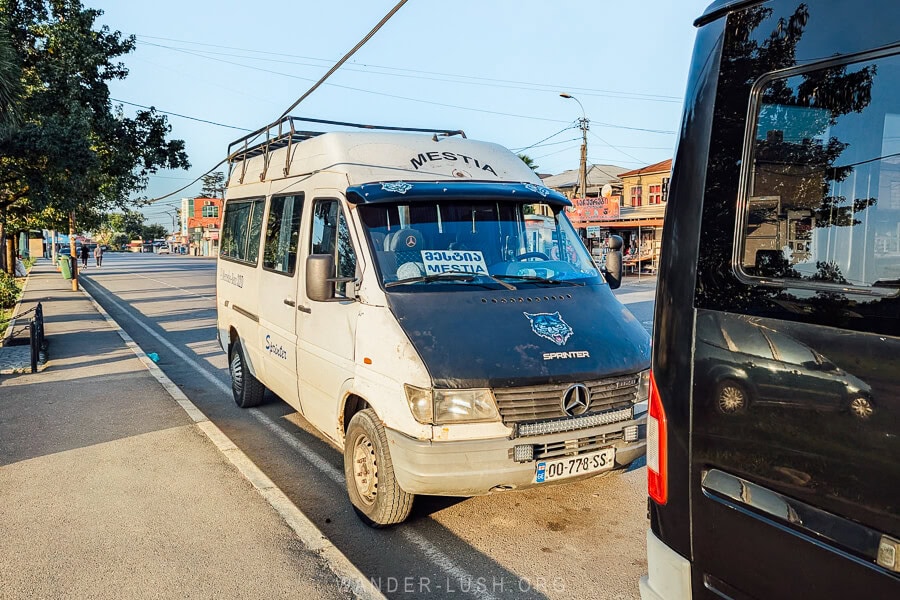
The road to Mestia is sealed but windy and steep. As of summer/autumn 2024 it is in a terrible state and desperately needs repairs (in 2025, the road is indeed scheduled to close for work). At present, there are large sections that have collapsed into the river valley, reducing the road to one lane.
If you are a nervous passenger, you should strongly consider hiring a private driver for this trip instead.
We recently drove our own car (a RAV4) from Zugdidi to Mestia as part of a Svaneti road trip. Personally I would not feel comfortable travelling this road in a marshrutka.
→ See my detailed Mestia transport guide for alternative options and more travel tips
What to pack for Zugdidi
- Mosquito spray – Zugdidi (and Samegrelo in general) is notorious for mosquitos, especially in summer!
- A refillable water bottle – There are plenty of mountain springs where you can fill up.
- A lightweight scarf – Required for women when entering churches and monasteries. A few in the area don’t supply scarves to borrow.
Georgia essentials
Here are the websites and services I personally use and recommend for Georgia. Check out my full list of travel resources for more tips.
FLIGHTS: Search for affordable flights to Tbilisi, Batumi or Kutaisi on Skyscanner.
TRAVEL INSURANCE: Insure your trip with HeyMondo, my preferred provider for single-trip and annual travel insurance (get 5% off when you book with my link).
SIM CARD: Magti is my preferred provider, with prices starting from 9 GEL/week for unlimited data. See this guide for all the details about buying a Georgian SIM card.
AIRPORT TRANSFERS: Most flights into Georgia arrive in the early hours. For ease, pre-book a private transfer from Tbilisi Airport to your hotel (from $17) or from Kutaisi Airport to Tbilisi (from $90) with my partners at GoTrip.ge.
ACCOMMODATION: Booking.com is the most widely used platform in Georgia. Use it to find family guesthouses, private apartments, hostels and hotels around the country.
CAR HIRE: Find a great deal on a rental car in Georgia – use the Local Rent website to book through a local agent (prices start from $20/day).
DAY TRIPS & CITY TOURS: Use Viator or Get Your Guide to browse a range of day trips and city tours. For off-beat programs, I recommend Friendly.ge (use the promocode wanderlush for 10% off). For in-depth day trips to Georgia’s wine regions, I recommend Eat This! Tours (use the promo code wanderlush for 5% off).
PRIVATE TRANSFERS: GoTrip.ge is a terrific service for booking a private professional driver and car for the day. Use it for A-to-B transfers, a customised round-trip itinerary, or a multi-day trip. You can stop wherever you like for as long as you like without the fixed price going up.
NEED SOME HELP?: Need feedback on your itinerary or personalised travel tips? I offer a one-on-one consultation call service for Tbilisi and Georgia. More information and bookings here.
